Strategic Analysis of Tesco PLC: PESTLE, SWOT, Five Forces and Value Chain Analysis
VerifiedAdded on 2023/06/13
|24
|6666
|372
AI Summary
This report provides a strategic analysis of Tesco PLC using PESTLE, SWOT, Five Forces and Value Chain Analysis. It includes an introduction to the company, its background, and the importance of strategic analysis. The report also covers the external business environment of Tesco using various strategic analysis tools.
Contribute Materials
Your contribution can guide someone’s learning journey. Share your
documents today.
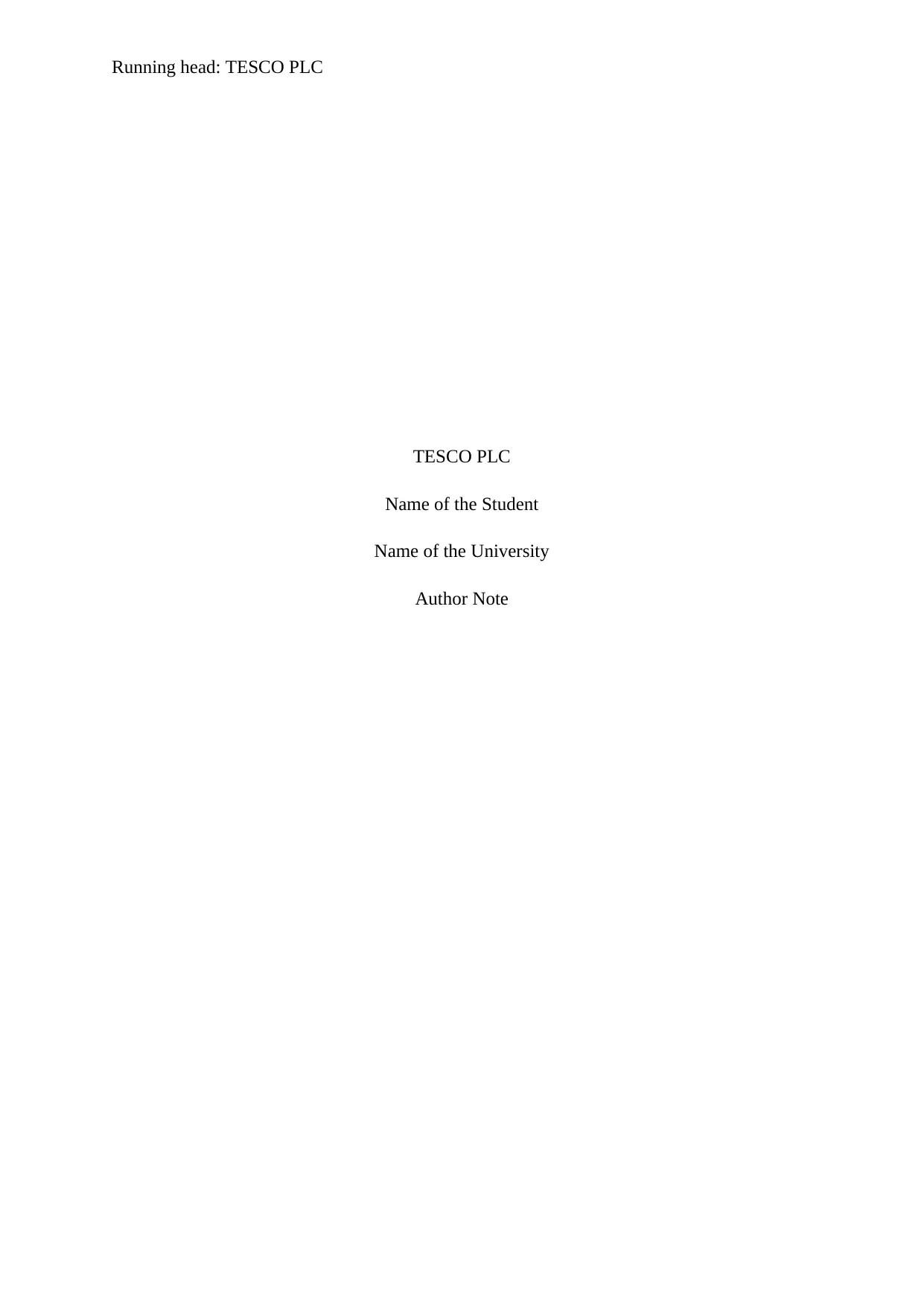
Running head: TESCO PLC
TESCO PLC
Name of the Student
Name of the University
Author Note
TESCO PLC
Name of the Student
Name of the University
Author Note
Secure Best Marks with AI Grader
Need help grading? Try our AI Grader for instant feedback on your assignments.
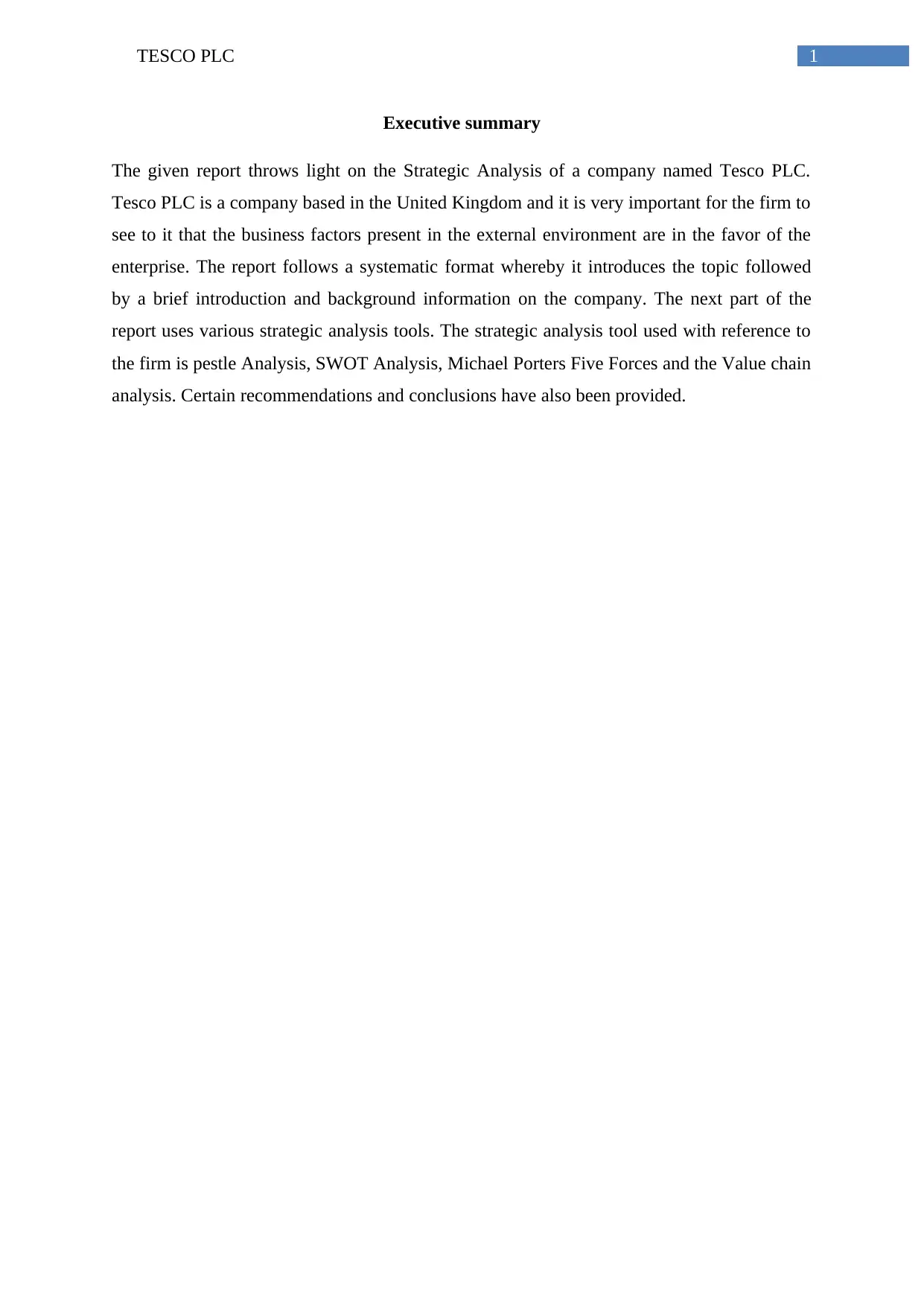
1TESCO PLC
Executive summary
The given report throws light on the Strategic Analysis of a company named Tesco PLC.
Tesco PLC is a company based in the United Kingdom and it is very important for the firm to
see to it that the business factors present in the external environment are in the favor of the
enterprise. The report follows a systematic format whereby it introduces the topic followed
by a brief introduction and background information on the company. The next part of the
report uses various strategic analysis tools. The strategic analysis tool used with reference to
the firm is pestle Analysis, SWOT Analysis, Michael Porters Five Forces and the Value chain
analysis. Certain recommendations and conclusions have also been provided.
Executive summary
The given report throws light on the Strategic Analysis of a company named Tesco PLC.
Tesco PLC is a company based in the United Kingdom and it is very important for the firm to
see to it that the business factors present in the external environment are in the favor of the
enterprise. The report follows a systematic format whereby it introduces the topic followed
by a brief introduction and background information on the company. The next part of the
report uses various strategic analysis tools. The strategic analysis tool used with reference to
the firm is pestle Analysis, SWOT Analysis, Michael Porters Five Forces and the Value chain
analysis. Certain recommendations and conclusions have also been provided.
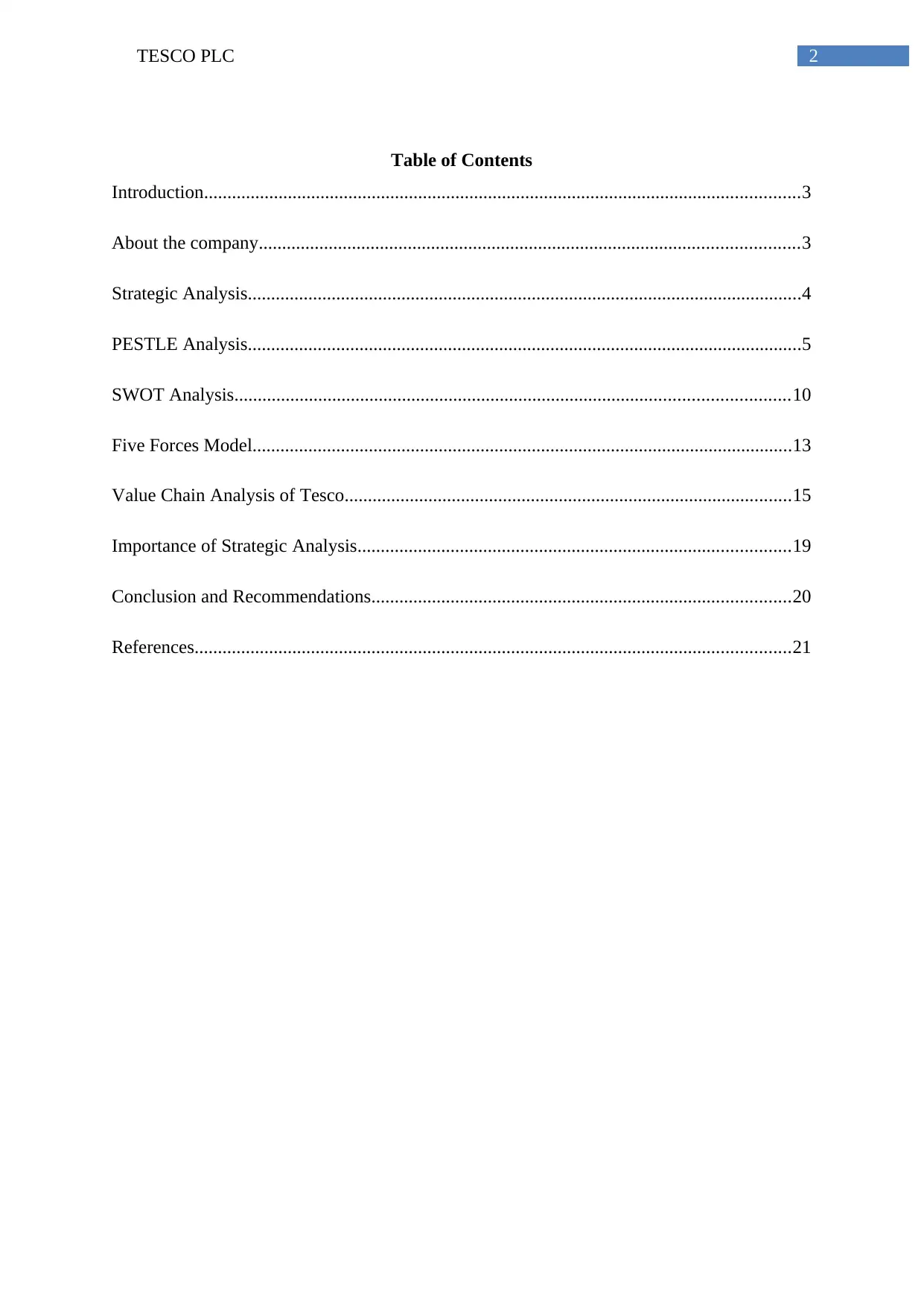
2TESCO PLC
Table of Contents
Introduction................................................................................................................................3
About the company....................................................................................................................3
Strategic Analysis.......................................................................................................................4
PESTLE Analysis.......................................................................................................................5
SWOT Analysis.......................................................................................................................10
Five Forces Model....................................................................................................................13
Value Chain Analysis of Tesco................................................................................................15
Importance of Strategic Analysis.............................................................................................19
Conclusion and Recommendations..........................................................................................20
References................................................................................................................................21
Table of Contents
Introduction................................................................................................................................3
About the company....................................................................................................................3
Strategic Analysis.......................................................................................................................4
PESTLE Analysis.......................................................................................................................5
SWOT Analysis.......................................................................................................................10
Five Forces Model....................................................................................................................13
Value Chain Analysis of Tesco................................................................................................15
Importance of Strategic Analysis.............................................................................................19
Conclusion and Recommendations..........................................................................................20
References................................................................................................................................21
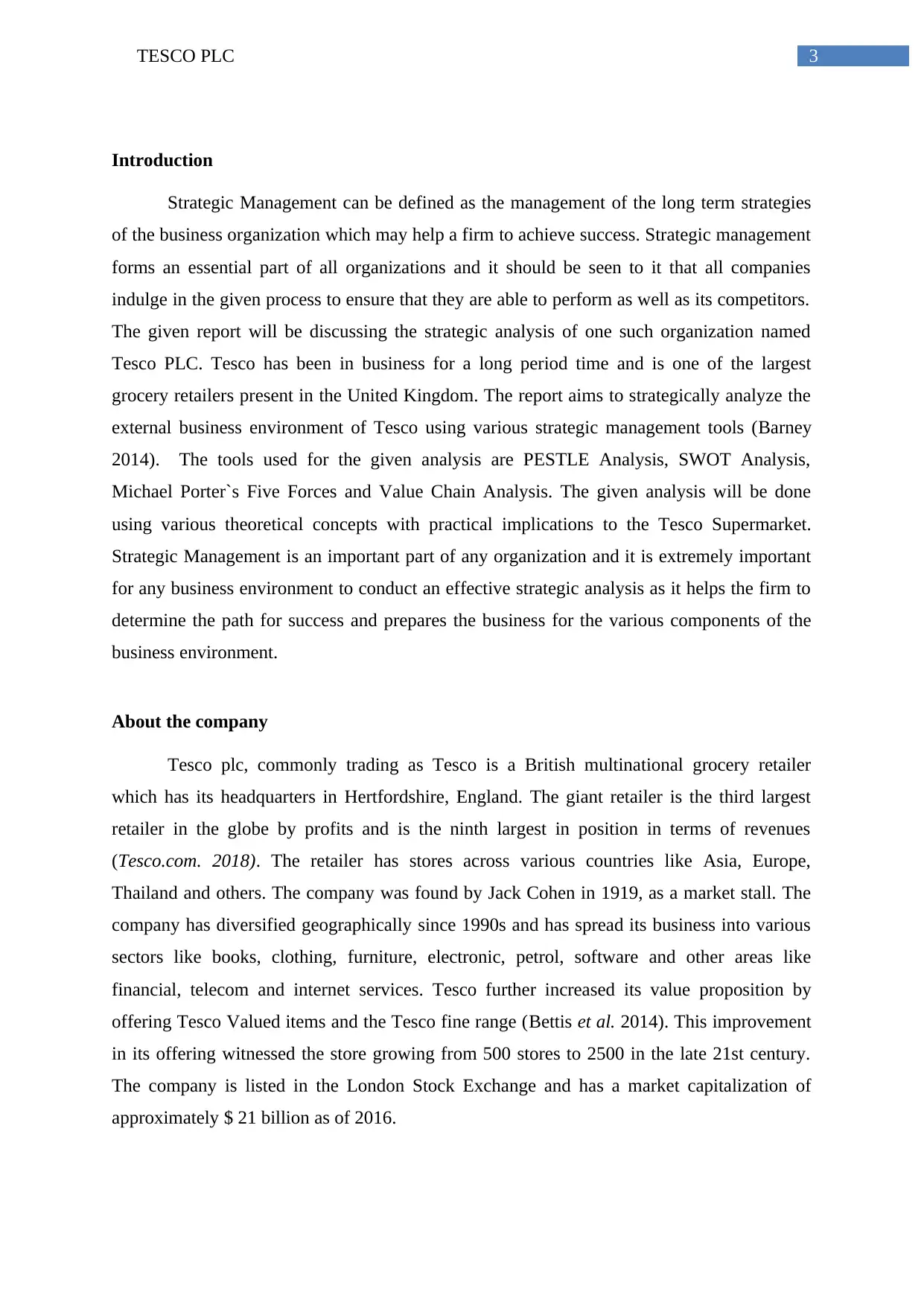
3TESCO PLC
Introduction
Strategic Management can be defined as the management of the long term strategies
of the business organization which may help a firm to achieve success. Strategic management
forms an essential part of all organizations and it should be seen to it that all companies
indulge in the given process to ensure that they are able to perform as well as its competitors.
The given report will be discussing the strategic analysis of one such organization named
Tesco PLC. Tesco has been in business for a long period time and is one of the largest
grocery retailers present in the United Kingdom. The report aims to strategically analyze the
external business environment of Tesco using various strategic management tools (Barney
2014). The tools used for the given analysis are PESTLE Analysis, SWOT Analysis,
Michael Porter`s Five Forces and Value Chain Analysis. The given analysis will be done
using various theoretical concepts with practical implications to the Tesco Supermarket.
Strategic Management is an important part of any organization and it is extremely important
for any business environment to conduct an effective strategic analysis as it helps the firm to
determine the path for success and prepares the business for the various components of the
business environment.
About the company
Tesco plc, commonly trading as Tesco is a British multinational grocery retailer
which has its headquarters in Hertfordshire, England. The giant retailer is the third largest
retailer in the globe by profits and is the ninth largest in position in terms of revenues
(Tesco.com. 2018). The retailer has stores across various countries like Asia, Europe,
Thailand and others. The company was found by Jack Cohen in 1919, as a market stall. The
company has diversified geographically since 1990s and has spread its business into various
sectors like books, clothing, furniture, electronic, petrol, software and other areas like
financial, telecom and internet services. Tesco further increased its value proposition by
offering Tesco Valued items and the Tesco fine range (Bettis et al. 2014). This improvement
in its offering witnessed the store growing from 500 stores to 2500 in the late 21st century.
The company is listed in the London Stock Exchange and has a market capitalization of
approximately $ 21 billion as of 2016.
Introduction
Strategic Management can be defined as the management of the long term strategies
of the business organization which may help a firm to achieve success. Strategic management
forms an essential part of all organizations and it should be seen to it that all companies
indulge in the given process to ensure that they are able to perform as well as its competitors.
The given report will be discussing the strategic analysis of one such organization named
Tesco PLC. Tesco has been in business for a long period time and is one of the largest
grocery retailers present in the United Kingdom. The report aims to strategically analyze the
external business environment of Tesco using various strategic management tools (Barney
2014). The tools used for the given analysis are PESTLE Analysis, SWOT Analysis,
Michael Porter`s Five Forces and Value Chain Analysis. The given analysis will be done
using various theoretical concepts with practical implications to the Tesco Supermarket.
Strategic Management is an important part of any organization and it is extremely important
for any business environment to conduct an effective strategic analysis as it helps the firm to
determine the path for success and prepares the business for the various components of the
business environment.
About the company
Tesco plc, commonly trading as Tesco is a British multinational grocery retailer
which has its headquarters in Hertfordshire, England. The giant retailer is the third largest
retailer in the globe by profits and is the ninth largest in position in terms of revenues
(Tesco.com. 2018). The retailer has stores across various countries like Asia, Europe,
Thailand and others. The company was found by Jack Cohen in 1919, as a market stall. The
company has diversified geographically since 1990s and has spread its business into various
sectors like books, clothing, furniture, electronic, petrol, software and other areas like
financial, telecom and internet services. Tesco further increased its value proposition by
offering Tesco Valued items and the Tesco fine range (Bettis et al. 2014). This improvement
in its offering witnessed the store growing from 500 stores to 2500 in the late 21st century.
The company is listed in the London Stock Exchange and has a market capitalization of
approximately $ 21 billion as of 2016.
Secure Best Marks with AI Grader
Need help grading? Try our AI Grader for instant feedback on your assignments.
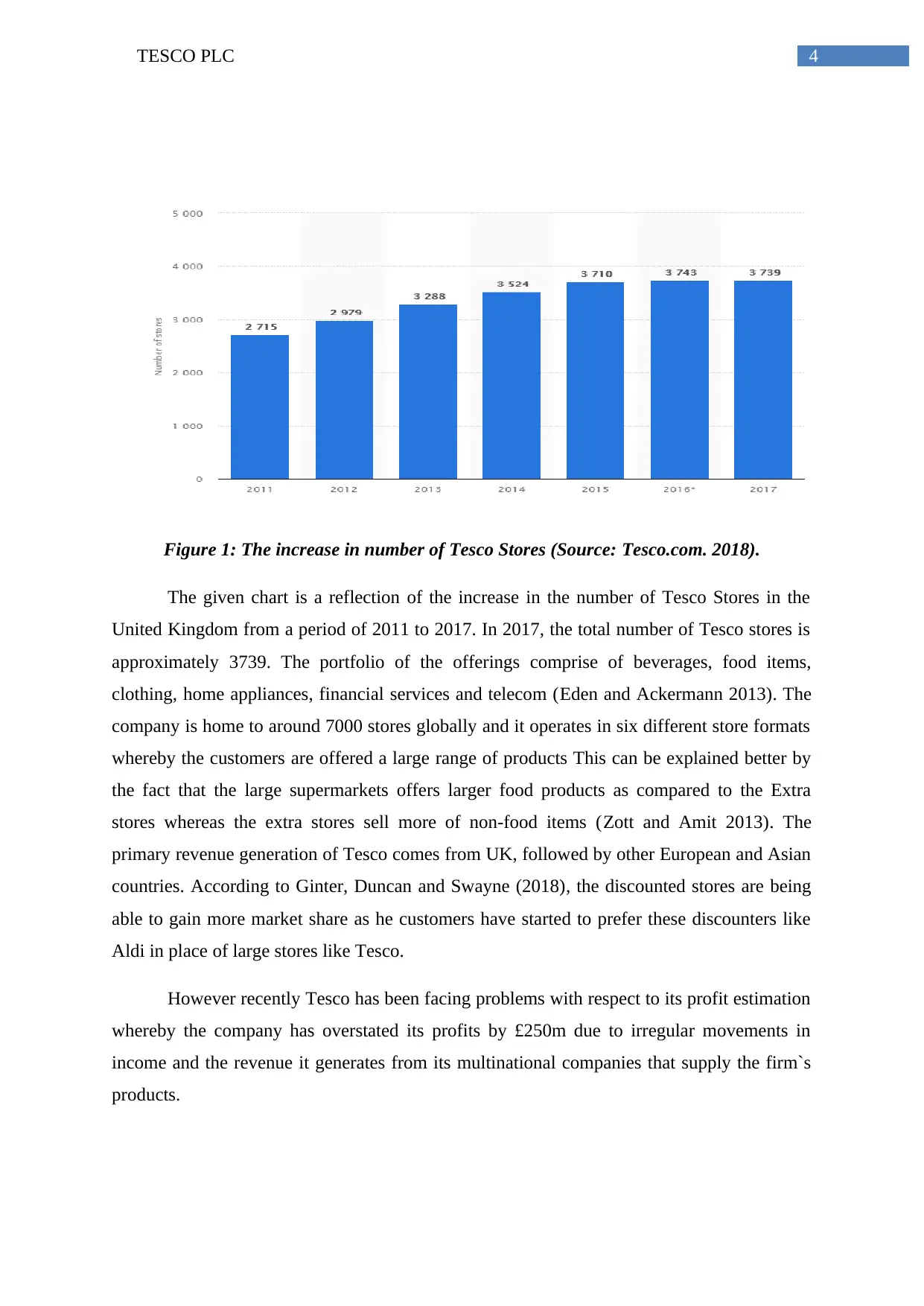
4TESCO PLC
Figure 1: The increase in number of Tesco Stores (Source: Tesco.com. 2018).
The given chart is a reflection of the increase in the number of Tesco Stores in the
United Kingdom from a period of 2011 to 2017. In 2017, the total number of Tesco stores is
approximately 3739. The portfolio of the offerings comprise of beverages, food items,
clothing, home appliances, financial services and telecom (Eden and Ackermann 2013). The
company is home to around 7000 stores globally and it operates in six different store formats
whereby the customers are offered a large range of products This can be explained better by
the fact that the large supermarkets offers larger food products as compared to the Extra
stores whereas the extra stores sell more of non-food items (Zott and Amit 2013). The
primary revenue generation of Tesco comes from UK, followed by other European and Asian
countries. According to Ginter, Duncan and Swayne (2018), the discounted stores are being
able to gain more market share as he customers have started to prefer these discounters like
Aldi in place of large stores like Tesco.
However recently Tesco has been facing problems with respect to its profit estimation
whereby the company has overstated its profits by £250m due to irregular movements in
income and the revenue it generates from its multinational companies that supply the firm`s
products.
Figure 1: The increase in number of Tesco Stores (Source: Tesco.com. 2018).
The given chart is a reflection of the increase in the number of Tesco Stores in the
United Kingdom from a period of 2011 to 2017. In 2017, the total number of Tesco stores is
approximately 3739. The portfolio of the offerings comprise of beverages, food items,
clothing, home appliances, financial services and telecom (Eden and Ackermann 2013). The
company is home to around 7000 stores globally and it operates in six different store formats
whereby the customers are offered a large range of products This can be explained better by
the fact that the large supermarkets offers larger food products as compared to the Extra
stores whereas the extra stores sell more of non-food items (Zott and Amit 2013). The
primary revenue generation of Tesco comes from UK, followed by other European and Asian
countries. According to Ginter, Duncan and Swayne (2018), the discounted stores are being
able to gain more market share as he customers have started to prefer these discounters like
Aldi in place of large stores like Tesco.
However recently Tesco has been facing problems with respect to its profit estimation
whereby the company has overstated its profits by £250m due to irregular movements in
income and the revenue it generates from its multinational companies that supply the firm`s
products.
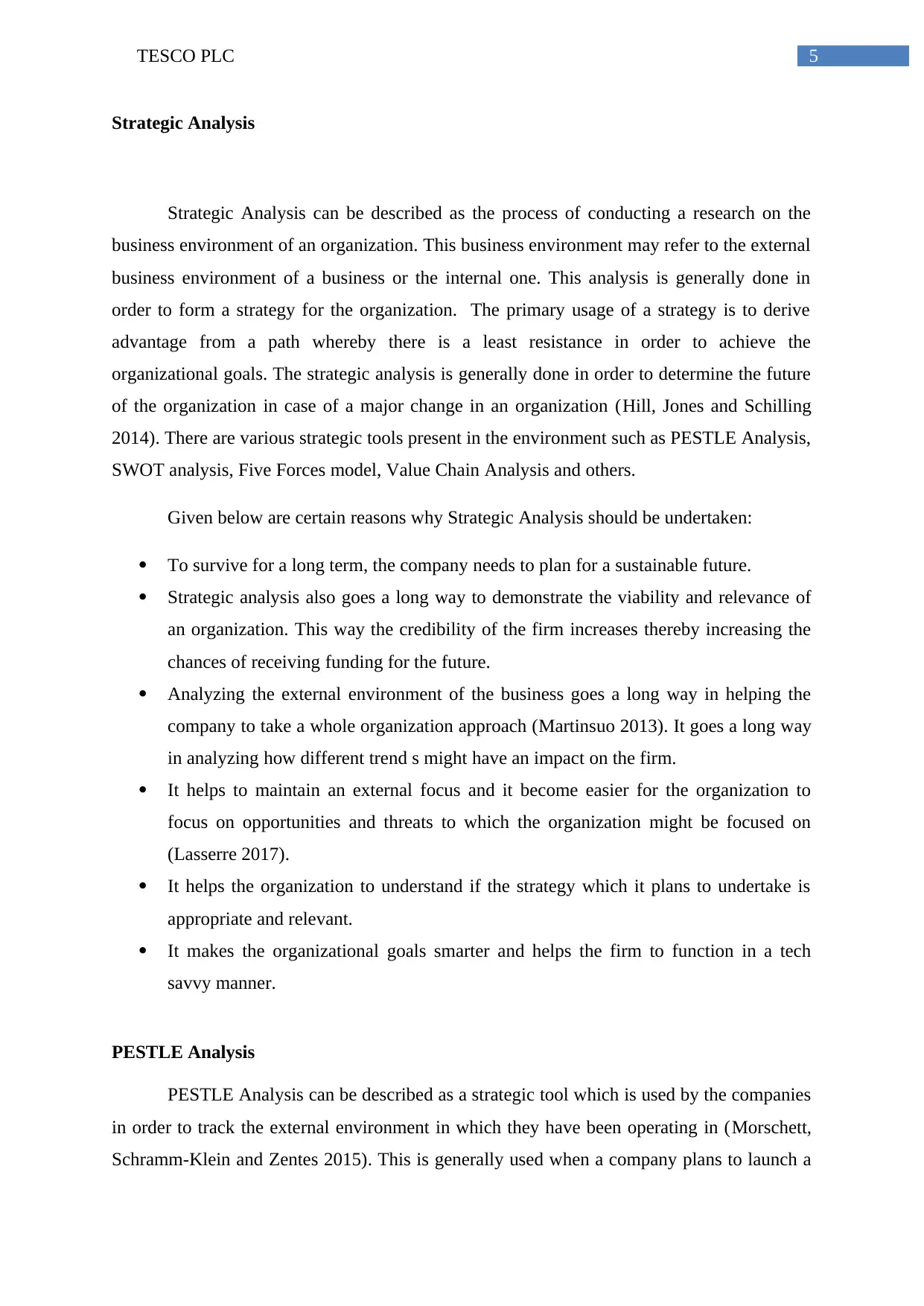
5TESCO PLC
Strategic Analysis
Strategic Analysis can be described as the process of conducting a research on the
business environment of an organization. This business environment may refer to the external
business environment of a business or the internal one. This analysis is generally done in
order to form a strategy for the organization. The primary usage of a strategy is to derive
advantage from a path whereby there is a least resistance in order to achieve the
organizational goals. The strategic analysis is generally done in order to determine the future
of the organization in case of a major change in an organization (Hill, Jones and Schilling
2014). There are various strategic tools present in the environment such as PESTLE Analysis,
SWOT analysis, Five Forces model, Value Chain Analysis and others.
Given below are certain reasons why Strategic Analysis should be undertaken:
To survive for a long term, the company needs to plan for a sustainable future.
Strategic analysis also goes a long way to demonstrate the viability and relevance of
an organization. This way the credibility of the firm increases thereby increasing the
chances of receiving funding for the future.
Analyzing the external environment of the business goes a long way in helping the
company to take a whole organization approach (Martinsuo 2013). It goes a long way
in analyzing how different trend s might have an impact on the firm.
It helps to maintain an external focus and it become easier for the organization to
focus on opportunities and threats to which the organization might be focused on
(Lasserre 2017).
It helps the organization to understand if the strategy which it plans to undertake is
appropriate and relevant.
It makes the organizational goals smarter and helps the firm to function in a tech
savvy manner.
PESTLE Analysis
PESTLE Analysis can be described as a strategic tool which is used by the companies
in order to track the external environment in which they have been operating in (Morschett,
Schramm-Klein and Zentes 2015). This is generally used when a company plans to launch a
Strategic Analysis
Strategic Analysis can be described as the process of conducting a research on the
business environment of an organization. This business environment may refer to the external
business environment of a business or the internal one. This analysis is generally done in
order to form a strategy for the organization. The primary usage of a strategy is to derive
advantage from a path whereby there is a least resistance in order to achieve the
organizational goals. The strategic analysis is generally done in order to determine the future
of the organization in case of a major change in an organization (Hill, Jones and Schilling
2014). There are various strategic tools present in the environment such as PESTLE Analysis,
SWOT analysis, Five Forces model, Value Chain Analysis and others.
Given below are certain reasons why Strategic Analysis should be undertaken:
To survive for a long term, the company needs to plan for a sustainable future.
Strategic analysis also goes a long way to demonstrate the viability and relevance of
an organization. This way the credibility of the firm increases thereby increasing the
chances of receiving funding for the future.
Analyzing the external environment of the business goes a long way in helping the
company to take a whole organization approach (Martinsuo 2013). It goes a long way
in analyzing how different trend s might have an impact on the firm.
It helps to maintain an external focus and it become easier for the organization to
focus on opportunities and threats to which the organization might be focused on
(Lasserre 2017).
It helps the organization to understand if the strategy which it plans to undertake is
appropriate and relevant.
It makes the organizational goals smarter and helps the firm to function in a tech
savvy manner.
PESTLE Analysis
PESTLE Analysis can be described as a strategic tool which is used by the companies
in order to track the external environment in which they have been operating in (Morschett,
Schramm-Klein and Zentes 2015). This is generally used when a company plans to launch a
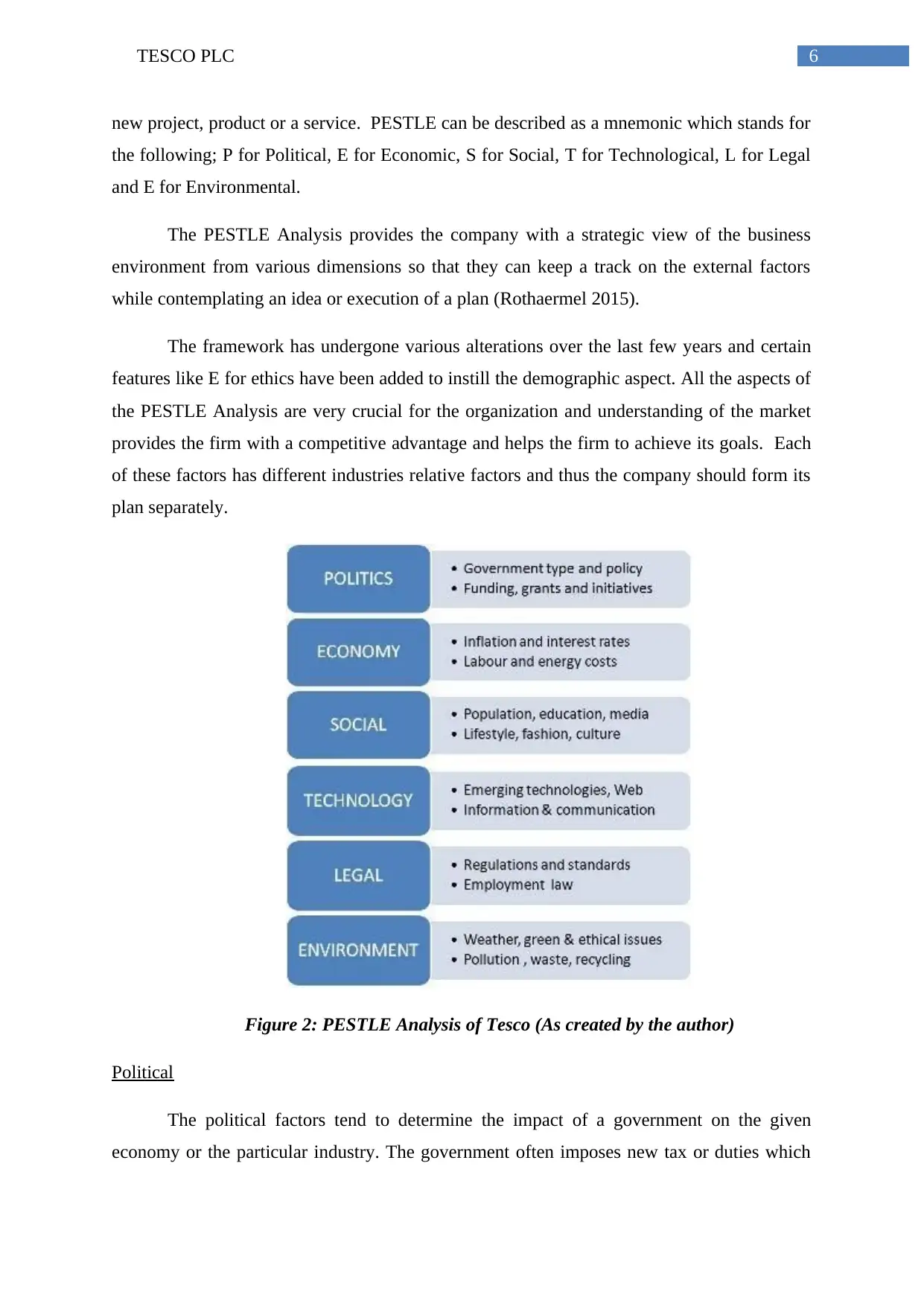
6TESCO PLC
new project, product or a service. PESTLE can be described as a mnemonic which stands for
the following; P for Political, E for Economic, S for Social, T for Technological, L for Legal
and E for Environmental.
The PESTLE Analysis provides the company with a strategic view of the business
environment from various dimensions so that they can keep a track on the external factors
while contemplating an idea or execution of a plan (Rothaermel 2015).
The framework has undergone various alterations over the last few years and certain
features like E for ethics have been added to instill the demographic aspect. All the aspects of
the PESTLE Analysis are very crucial for the organization and understanding of the market
provides the firm with a competitive advantage and helps the firm to achieve its goals. Each
of these factors has different industries relative factors and thus the company should form its
plan separately.
Figure 2: PESTLE Analysis of Tesco (As created by the author)
Political
The political factors tend to determine the impact of a government on the given
economy or the particular industry. The government often imposes new tax or duties which
new project, product or a service. PESTLE can be described as a mnemonic which stands for
the following; P for Political, E for Economic, S for Social, T for Technological, L for Legal
and E for Environmental.
The PESTLE Analysis provides the company with a strategic view of the business
environment from various dimensions so that they can keep a track on the external factors
while contemplating an idea or execution of a plan (Rothaermel 2015).
The framework has undergone various alterations over the last few years and certain
features like E for ethics have been added to instill the demographic aspect. All the aspects of
the PESTLE Analysis are very crucial for the organization and understanding of the market
provides the firm with a competitive advantage and helps the firm to achieve its goals. Each
of these factors has different industries relative factors and thus the company should form its
plan separately.
Figure 2: PESTLE Analysis of Tesco (As created by the author)
Political
The political factors tend to determine the impact of a government on the given
economy or the particular industry. The government often imposes new tax or duties which
Paraphrase This Document
Need a fresh take? Get an instant paraphrase of this document with our AI Paraphraser
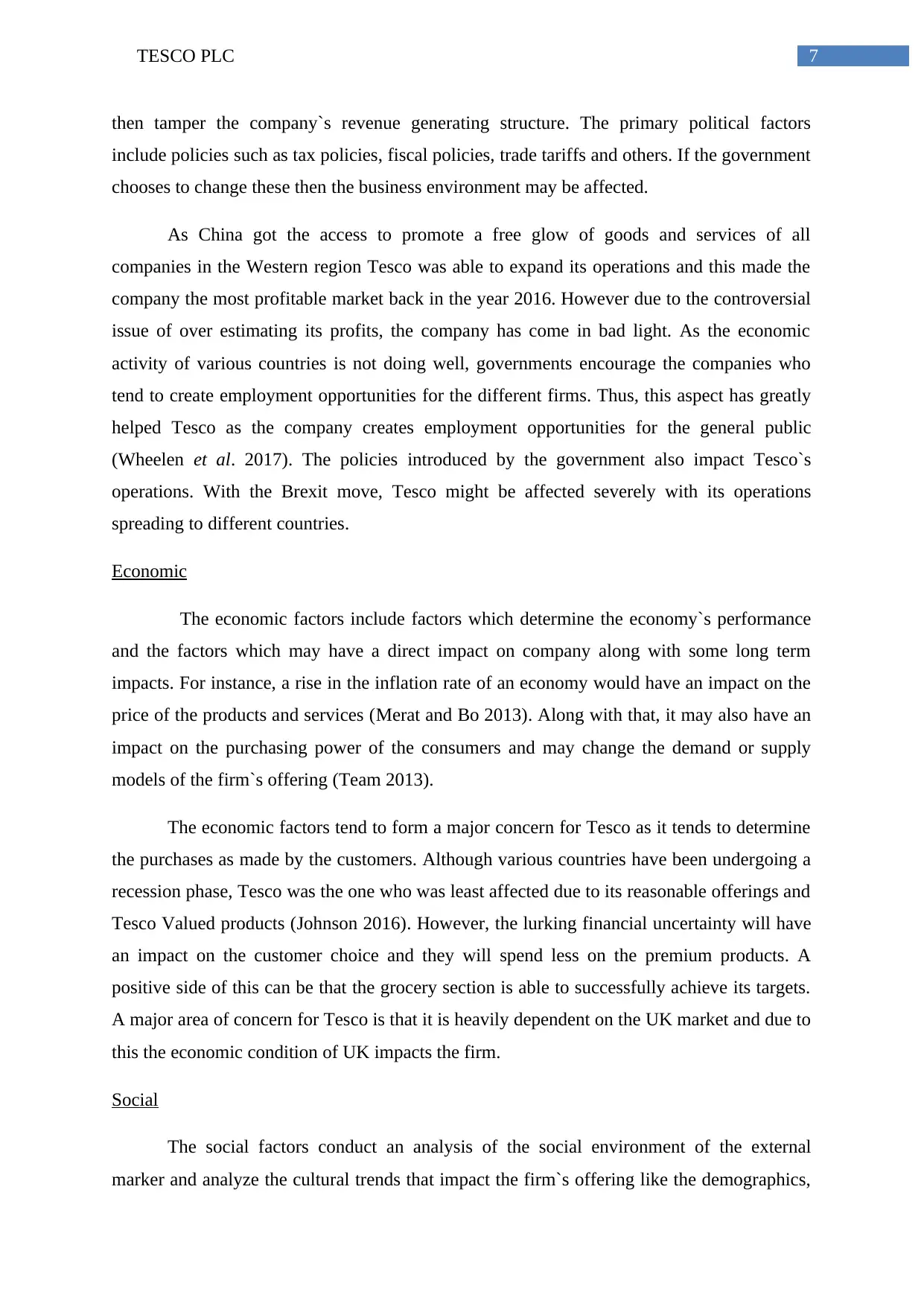
7TESCO PLC
then tamper the company`s revenue generating structure. The primary political factors
include policies such as tax policies, fiscal policies, trade tariffs and others. If the government
chooses to change these then the business environment may be affected.
As China got the access to promote a free glow of goods and services of all
companies in the Western region Tesco was able to expand its operations and this made the
company the most profitable market back in the year 2016. However due to the controversial
issue of over estimating its profits, the company has come in bad light. As the economic
activity of various countries is not doing well, governments encourage the companies who
tend to create employment opportunities for the different firms. Thus, this aspect has greatly
helped Tesco as the company creates employment opportunities for the general public
(Wheelen et al. 2017). The policies introduced by the government also impact Tesco`s
operations. With the Brexit move, Tesco might be affected severely with its operations
spreading to different countries.
Economic
The economic factors include factors which determine the economy`s performance
and the factors which may have a direct impact on company along with some long term
impacts. For instance, a rise in the inflation rate of an economy would have an impact on the
price of the products and services (Merat and Bo 2013). Along with that, it may also have an
impact on the purchasing power of the consumers and may change the demand or supply
models of the firm`s offering (Team 2013).
The economic factors tend to form a major concern for Tesco as it tends to determine
the purchases as made by the customers. Although various countries have been undergoing a
recession phase, Tesco was the one who was least affected due to its reasonable offerings and
Tesco Valued products (Johnson 2016). However, the lurking financial uncertainty will have
an impact on the customer choice and they will spend less on the premium products. A
positive side of this can be that the grocery section is able to successfully achieve its targets.
A major area of concern for Tesco is that it is heavily dependent on the UK market and due to
this the economic condition of UK impacts the firm.
Social
The social factors conduct an analysis of the social environment of the external
marker and analyze the cultural trends that impact the firm`s offering like the demographics,
then tamper the company`s revenue generating structure. The primary political factors
include policies such as tax policies, fiscal policies, trade tariffs and others. If the government
chooses to change these then the business environment may be affected.
As China got the access to promote a free glow of goods and services of all
companies in the Western region Tesco was able to expand its operations and this made the
company the most profitable market back in the year 2016. However due to the controversial
issue of over estimating its profits, the company has come in bad light. As the economic
activity of various countries is not doing well, governments encourage the companies who
tend to create employment opportunities for the different firms. Thus, this aspect has greatly
helped Tesco as the company creates employment opportunities for the general public
(Wheelen et al. 2017). The policies introduced by the government also impact Tesco`s
operations. With the Brexit move, Tesco might be affected severely with its operations
spreading to different countries.
Economic
The economic factors include factors which determine the economy`s performance
and the factors which may have a direct impact on company along with some long term
impacts. For instance, a rise in the inflation rate of an economy would have an impact on the
price of the products and services (Merat and Bo 2013). Along with that, it may also have an
impact on the purchasing power of the consumers and may change the demand or supply
models of the firm`s offering (Team 2013).
The economic factors tend to form a major concern for Tesco as it tends to determine
the purchases as made by the customers. Although various countries have been undergoing a
recession phase, Tesco was the one who was least affected due to its reasonable offerings and
Tesco Valued products (Johnson 2016). However, the lurking financial uncertainty will have
an impact on the customer choice and they will spend less on the premium products. A
positive side of this can be that the grocery section is able to successfully achieve its targets.
A major area of concern for Tesco is that it is heavily dependent on the UK market and due to
this the economic condition of UK impacts the firm.
Social
The social factors conduct an analysis of the social environment of the external
marker and analyze the cultural trends that impact the firm`s offering like the demographics,
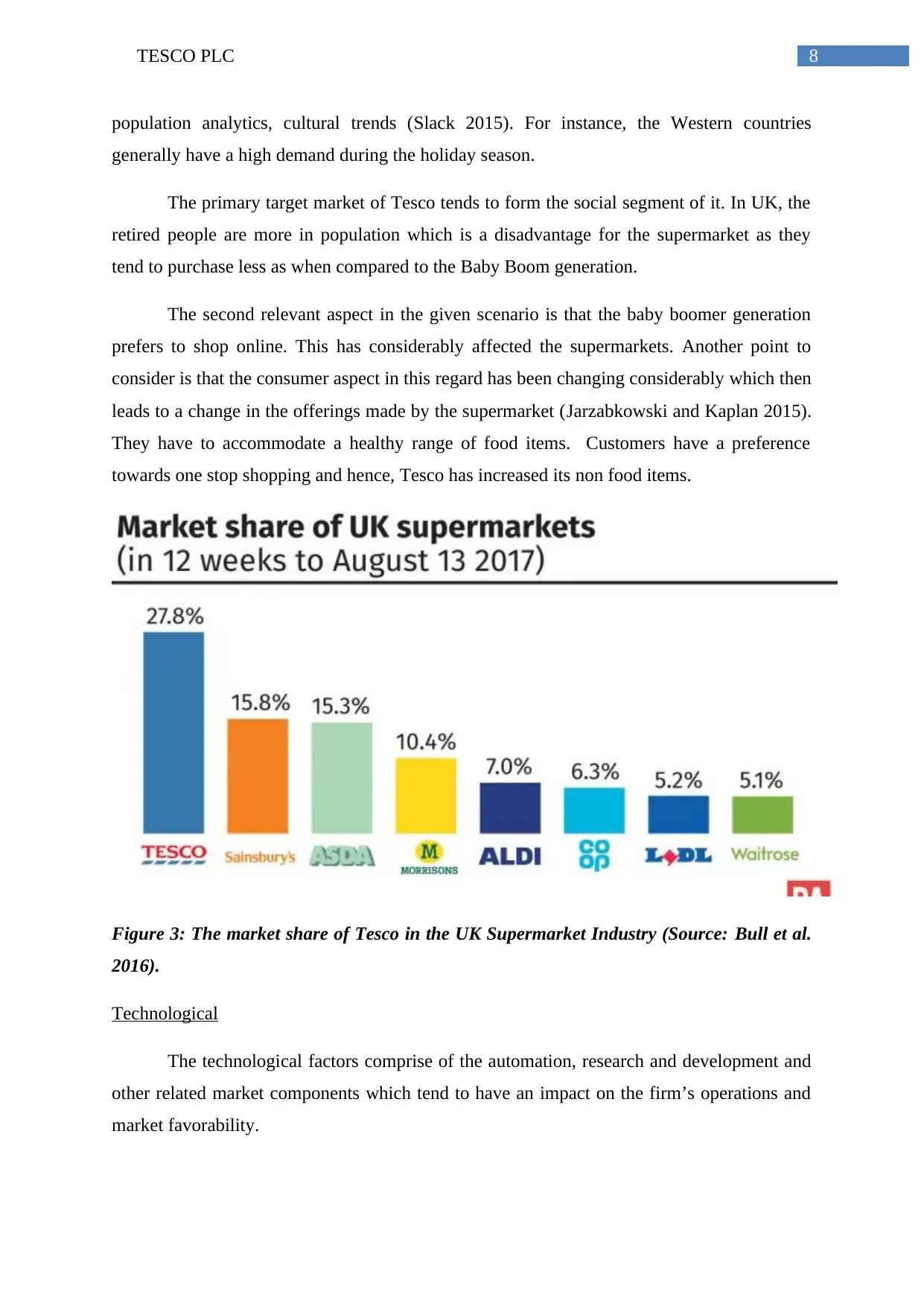
8TESCO PLC
population analytics, cultural trends (Slack 2015). For instance, the Western countries
generally have a high demand during the holiday season.
The primary target market of Tesco tends to form the social segment of it. In UK, the
retired people are more in population which is a disadvantage for the supermarket as they
tend to purchase less as when compared to the Baby Boom generation.
The second relevant aspect in the given scenario is that the baby boomer generation
prefers to shop online. This has considerably affected the supermarkets. Another point to
consider is that the consumer aspect in this regard has been changing considerably which then
leads to a change in the offerings made by the supermarket (Jarzabkowski and Kaplan 2015).
They have to accommodate a healthy range of food items. Customers have a preference
towards one stop shopping and hence, Tesco has increased its non food items.
Figure 3: The market share of Tesco in the UK Supermarket Industry (Source: Bull et al.
2016).
Technological
The technological factors comprise of the automation, research and development and
other related market components which tend to have an impact on the firm’s operations and
market favorability.
population analytics, cultural trends (Slack 2015). For instance, the Western countries
generally have a high demand during the holiday season.
The primary target market of Tesco tends to form the social segment of it. In UK, the
retired people are more in population which is a disadvantage for the supermarket as they
tend to purchase less as when compared to the Baby Boom generation.
The second relevant aspect in the given scenario is that the baby boomer generation
prefers to shop online. This has considerably affected the supermarkets. Another point to
consider is that the consumer aspect in this regard has been changing considerably which then
leads to a change in the offerings made by the supermarket (Jarzabkowski and Kaplan 2015).
They have to accommodate a healthy range of food items. Customers have a preference
towards one stop shopping and hence, Tesco has increased its non food items.
Figure 3: The market share of Tesco in the UK Supermarket Industry (Source: Bull et al.
2016).
Technological
The technological factors comprise of the automation, research and development and
other related market components which tend to have an impact on the firm’s operations and
market favorability.
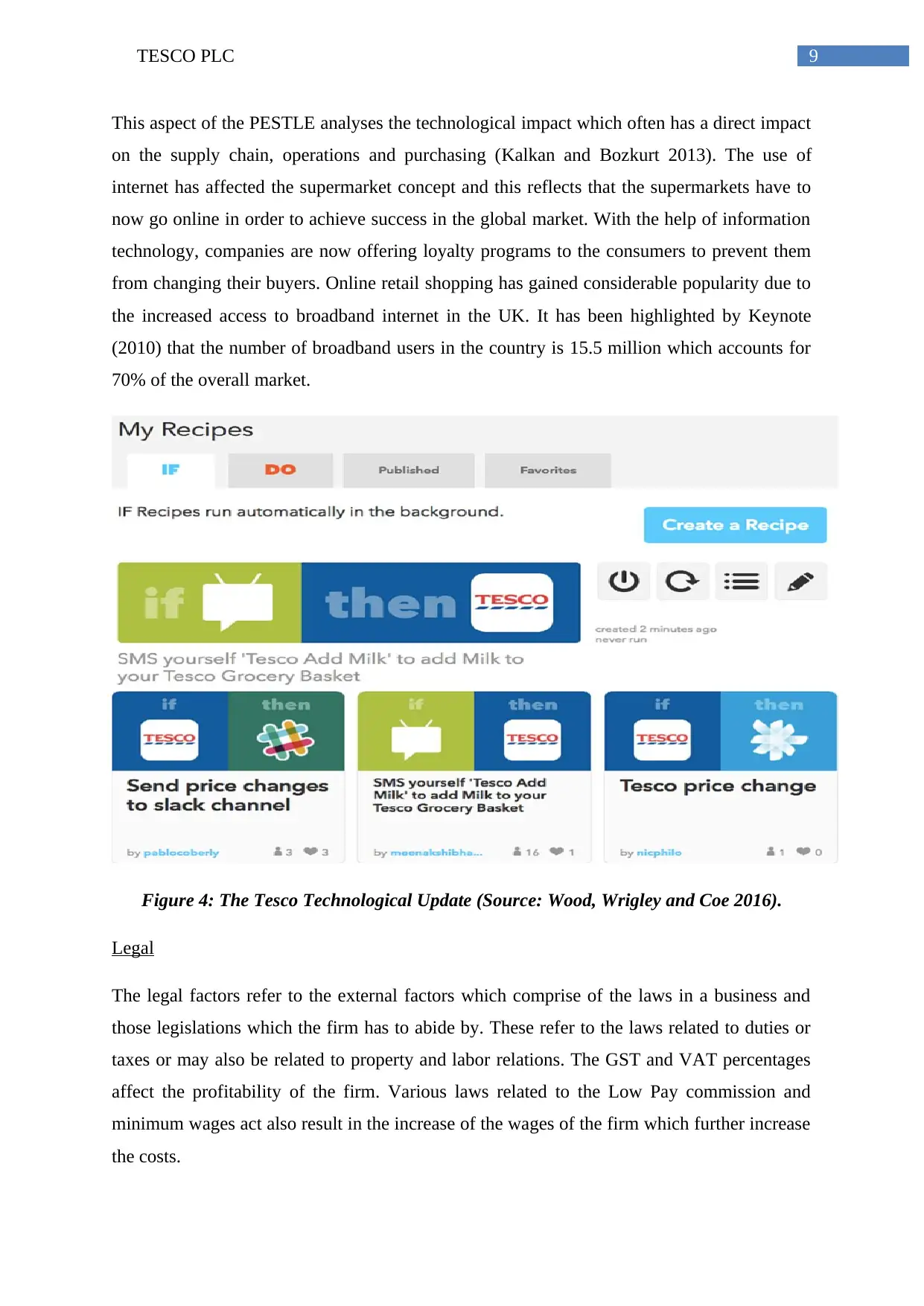
9TESCO PLC
This aspect of the PESTLE analyses the technological impact which often has a direct impact
on the supply chain, operations and purchasing (Kalkan and Bozkurt 2013). The use of
internet has affected the supermarket concept and this reflects that the supermarkets have to
now go online in order to achieve success in the global market. With the help of information
technology, companies are now offering loyalty programs to the consumers to prevent them
from changing their buyers. Online retail shopping has gained considerable popularity due to
the increased access to broadband internet in the UK. It has been highlighted by Keynote
(2010) that the number of broadband users in the country is 15.5 million which accounts for
70% of the overall market.
Figure 4: The Tesco Technological Update (Source: Wood, Wrigley and Coe 2016).
Legal
The legal factors refer to the external factors which comprise of the laws in a business and
those legislations which the firm has to abide by. These refer to the laws related to duties or
taxes or may also be related to property and labor relations. The GST and VAT percentages
affect the profitability of the firm. Various laws related to the Low Pay commission and
minimum wages act also result in the increase of the wages of the firm which further increase
the costs.
This aspect of the PESTLE analyses the technological impact which often has a direct impact
on the supply chain, operations and purchasing (Kalkan and Bozkurt 2013). The use of
internet has affected the supermarket concept and this reflects that the supermarkets have to
now go online in order to achieve success in the global market. With the help of information
technology, companies are now offering loyalty programs to the consumers to prevent them
from changing their buyers. Online retail shopping has gained considerable popularity due to
the increased access to broadband internet in the UK. It has been highlighted by Keynote
(2010) that the number of broadband users in the country is 15.5 million which accounts for
70% of the overall market.
Figure 4: The Tesco Technological Update (Source: Wood, Wrigley and Coe 2016).
Legal
The legal factors refer to the external factors which comprise of the laws in a business and
those legislations which the firm has to abide by. These refer to the laws related to duties or
taxes or may also be related to property and labor relations. The GST and VAT percentages
affect the profitability of the firm. Various laws related to the Low Pay commission and
minimum wages act also result in the increase of the wages of the firm which further increase
the costs.
Secure Best Marks with AI Grader
Need help grading? Try our AI Grader for instant feedback on your assignments.
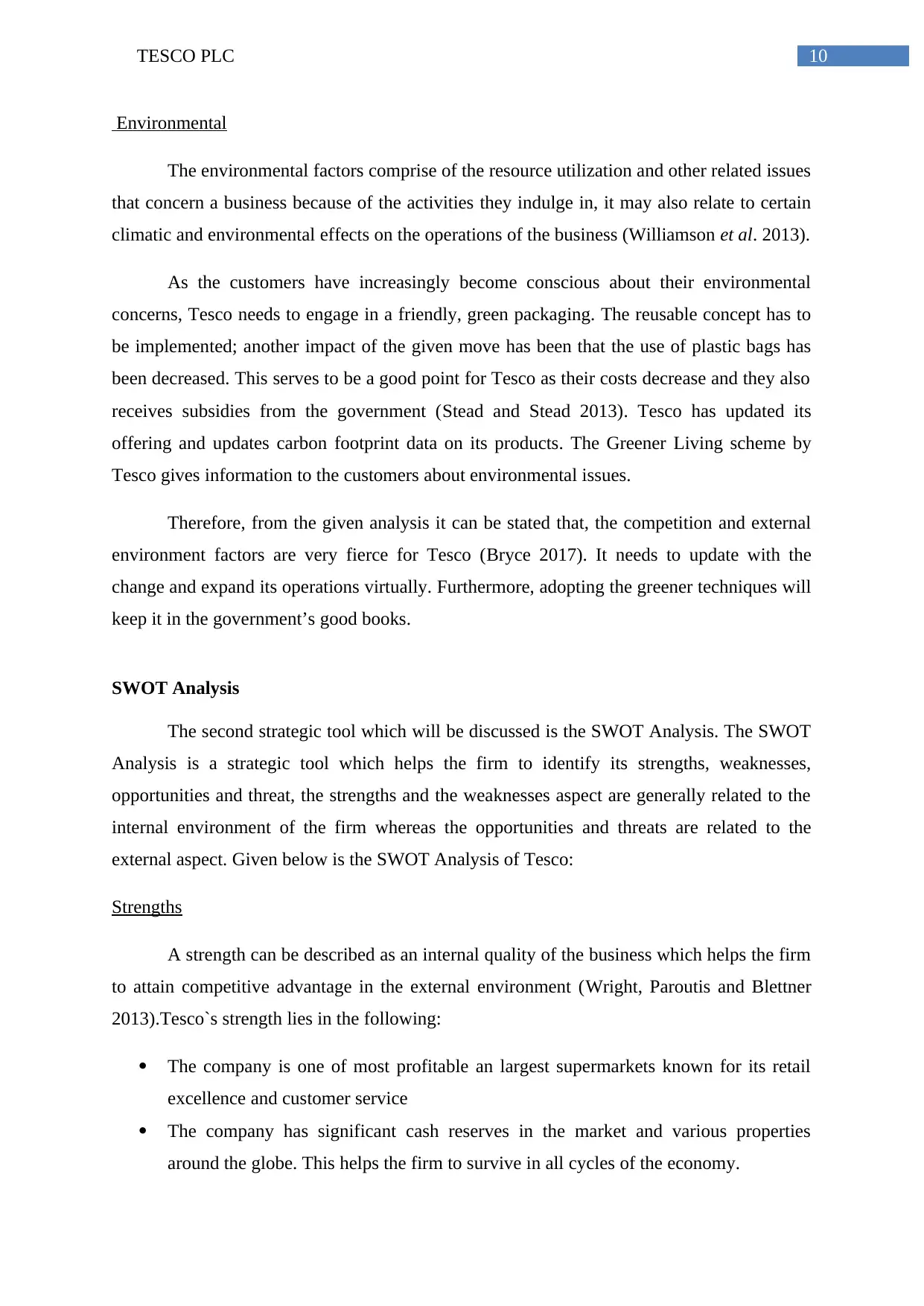
10TESCO PLC
Environmental
The environmental factors comprise of the resource utilization and other related issues
that concern a business because of the activities they indulge in, it may also relate to certain
climatic and environmental effects on the operations of the business (Williamson et al. 2013).
As the customers have increasingly become conscious about their environmental
concerns, Tesco needs to engage in a friendly, green packaging. The reusable concept has to
be implemented; another impact of the given move has been that the use of plastic bags has
been decreased. This serves to be a good point for Tesco as their costs decrease and they also
receives subsidies from the government (Stead and Stead 2013). Tesco has updated its
offering and updates carbon footprint data on its products. The Greener Living scheme by
Tesco gives information to the customers about environmental issues.
Therefore, from the given analysis it can be stated that, the competition and external
environment factors are very fierce for Tesco (Bryce 2017). It needs to update with the
change and expand its operations virtually. Furthermore, adopting the greener techniques will
keep it in the government’s good books.
SWOT Analysis
The second strategic tool which will be discussed is the SWOT Analysis. The SWOT
Analysis is a strategic tool which helps the firm to identify its strengths, weaknesses,
opportunities and threat, the strengths and the weaknesses aspect are generally related to the
internal environment of the firm whereas the opportunities and threats are related to the
external aspect. Given below is the SWOT Analysis of Tesco:
Strengths
A strength can be described as an internal quality of the business which helps the firm
to attain competitive advantage in the external environment (Wright, Paroutis and Blettner
2013).Tesco`s strength lies in the following:
The company is one of most profitable an largest supermarkets known for its retail
excellence and customer service
The company has significant cash reserves in the market and various properties
around the globe. This helps the firm to survive in all cycles of the economy.
Environmental
The environmental factors comprise of the resource utilization and other related issues
that concern a business because of the activities they indulge in, it may also relate to certain
climatic and environmental effects on the operations of the business (Williamson et al. 2013).
As the customers have increasingly become conscious about their environmental
concerns, Tesco needs to engage in a friendly, green packaging. The reusable concept has to
be implemented; another impact of the given move has been that the use of plastic bags has
been decreased. This serves to be a good point for Tesco as their costs decrease and they also
receives subsidies from the government (Stead and Stead 2013). Tesco has updated its
offering and updates carbon footprint data on its products. The Greener Living scheme by
Tesco gives information to the customers about environmental issues.
Therefore, from the given analysis it can be stated that, the competition and external
environment factors are very fierce for Tesco (Bryce 2017). It needs to update with the
change and expand its operations virtually. Furthermore, adopting the greener techniques will
keep it in the government’s good books.
SWOT Analysis
The second strategic tool which will be discussed is the SWOT Analysis. The SWOT
Analysis is a strategic tool which helps the firm to identify its strengths, weaknesses,
opportunities and threat, the strengths and the weaknesses aspect are generally related to the
internal environment of the firm whereas the opportunities and threats are related to the
external aspect. Given below is the SWOT Analysis of Tesco:
Strengths
A strength can be described as an internal quality of the business which helps the firm
to attain competitive advantage in the external environment (Wright, Paroutis and Blettner
2013).Tesco`s strength lies in the following:
The company is one of most profitable an largest supermarkets known for its retail
excellence and customer service
The company has significant cash reserves in the market and various properties
around the globe. This helps the firm to survive in all cycles of the economy.
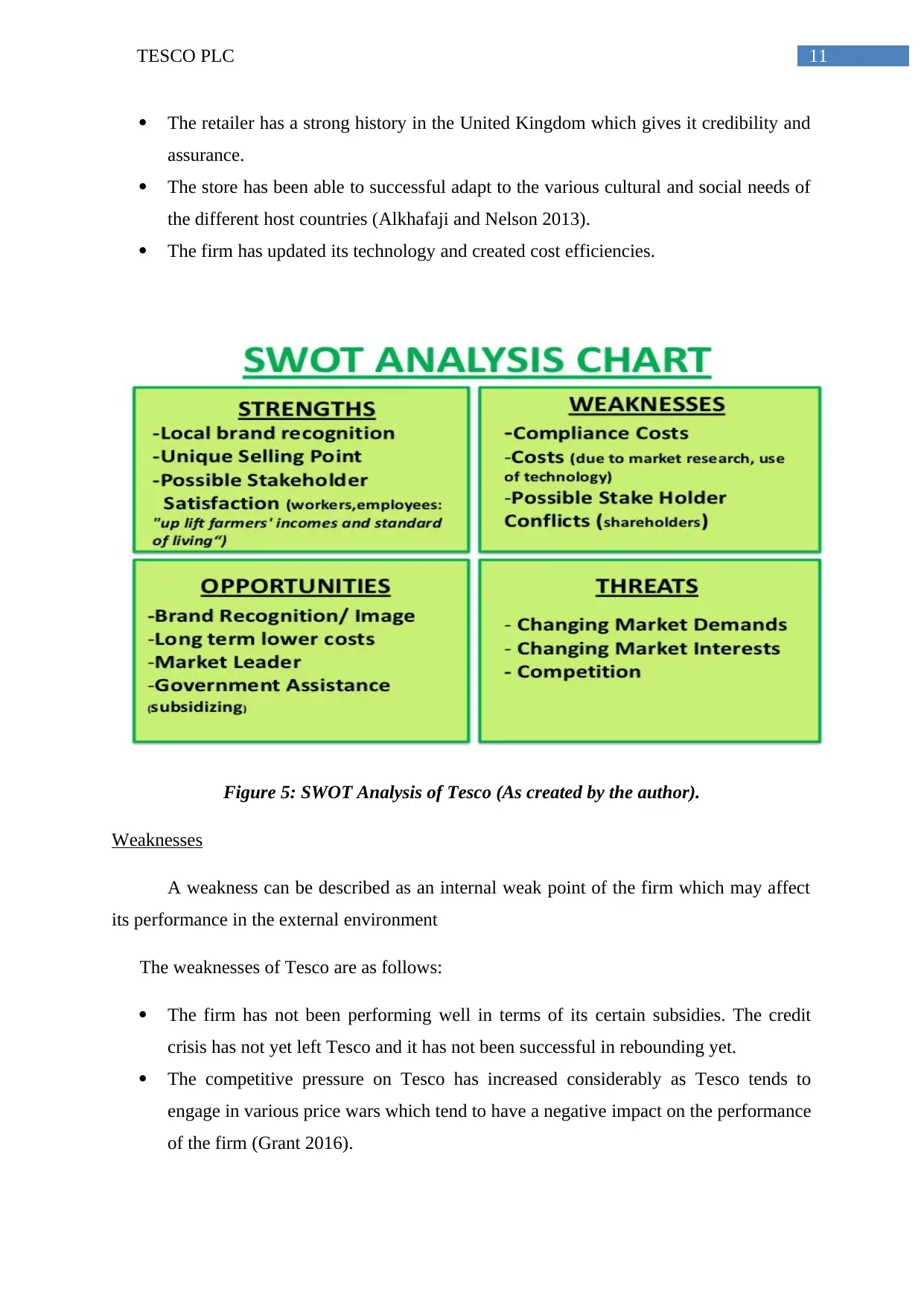
11TESCO PLC
The retailer has a strong history in the United Kingdom which gives it credibility and
assurance.
The store has been able to successful adapt to the various cultural and social needs of
the different host countries (Alkhafaji and Nelson 2013).
The firm has updated its technology and created cost efficiencies.
Figure 5: SWOT Analysis of Tesco (As created by the author).
Weaknesses
A weakness can be described as an internal weak point of the firm which may affect
its performance in the external environment
The weaknesses of Tesco are as follows:
The firm has not been performing well in terms of its certain subsidies. The credit
crisis has not yet left Tesco and it has not been successful in rebounding yet.
The competitive pressure on Tesco has increased considerably as Tesco tends to
engage in various price wars which tend to have a negative impact on the performance
of the firm (Grant 2016).
The retailer has a strong history in the United Kingdom which gives it credibility and
assurance.
The store has been able to successful adapt to the various cultural and social needs of
the different host countries (Alkhafaji and Nelson 2013).
The firm has updated its technology and created cost efficiencies.
Figure 5: SWOT Analysis of Tesco (As created by the author).
Weaknesses
A weakness can be described as an internal weak point of the firm which may affect
its performance in the external environment
The weaknesses of Tesco are as follows:
The firm has not been performing well in terms of its certain subsidies. The credit
crisis has not yet left Tesco and it has not been successful in rebounding yet.
The competitive pressure on Tesco has increased considerably as Tesco tends to
engage in various price wars which tend to have a negative impact on the performance
of the firm (Grant 2016).
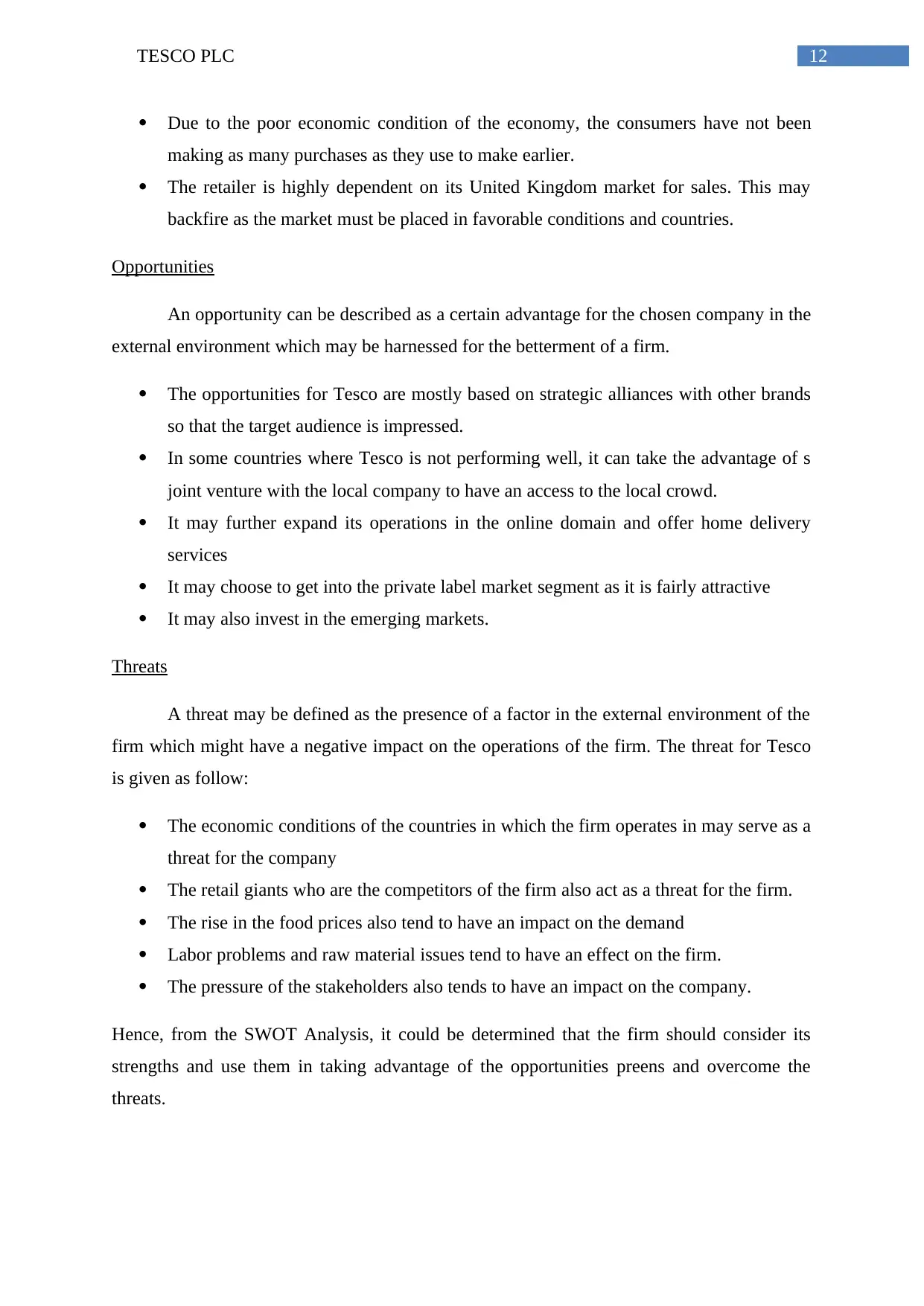
12TESCO PLC
Due to the poor economic condition of the economy, the consumers have not been
making as many purchases as they use to make earlier.
The retailer is highly dependent on its United Kingdom market for sales. This may
backfire as the market must be placed in favorable conditions and countries.
Opportunities
An opportunity can be described as a certain advantage for the chosen company in the
external environment which may be harnessed for the betterment of a firm.
The opportunities for Tesco are mostly based on strategic alliances with other brands
so that the target audience is impressed.
In some countries where Tesco is not performing well, it can take the advantage of s
joint venture with the local company to have an access to the local crowd.
It may further expand its operations in the online domain and offer home delivery
services
It may choose to get into the private label market segment as it is fairly attractive
It may also invest in the emerging markets.
Threats
A threat may be defined as the presence of a factor in the external environment of the
firm which might have a negative impact on the operations of the firm. The threat for Tesco
is given as follow:
The economic conditions of the countries in which the firm operates in may serve as a
threat for the company
The retail giants who are the competitors of the firm also act as a threat for the firm.
The rise in the food prices also tend to have an impact on the demand
Labor problems and raw material issues tend to have an effect on the firm.
The pressure of the stakeholders also tends to have an impact on the company.
Hence, from the SWOT Analysis, it could be determined that the firm should consider its
strengths and use them in taking advantage of the opportunities preens and overcome the
threats.
Due to the poor economic condition of the economy, the consumers have not been
making as many purchases as they use to make earlier.
The retailer is highly dependent on its United Kingdom market for sales. This may
backfire as the market must be placed in favorable conditions and countries.
Opportunities
An opportunity can be described as a certain advantage for the chosen company in the
external environment which may be harnessed for the betterment of a firm.
The opportunities for Tesco are mostly based on strategic alliances with other brands
so that the target audience is impressed.
In some countries where Tesco is not performing well, it can take the advantage of s
joint venture with the local company to have an access to the local crowd.
It may further expand its operations in the online domain and offer home delivery
services
It may choose to get into the private label market segment as it is fairly attractive
It may also invest in the emerging markets.
Threats
A threat may be defined as the presence of a factor in the external environment of the
firm which might have a negative impact on the operations of the firm. The threat for Tesco
is given as follow:
The economic conditions of the countries in which the firm operates in may serve as a
threat for the company
The retail giants who are the competitors of the firm also act as a threat for the firm.
The rise in the food prices also tend to have an impact on the demand
Labor problems and raw material issues tend to have an effect on the firm.
The pressure of the stakeholders also tends to have an impact on the company.
Hence, from the SWOT Analysis, it could be determined that the firm should consider its
strengths and use them in taking advantage of the opportunities preens and overcome the
threats.
Paraphrase This Document
Need a fresh take? Get an instant paraphrase of this document with our AI Paraphraser
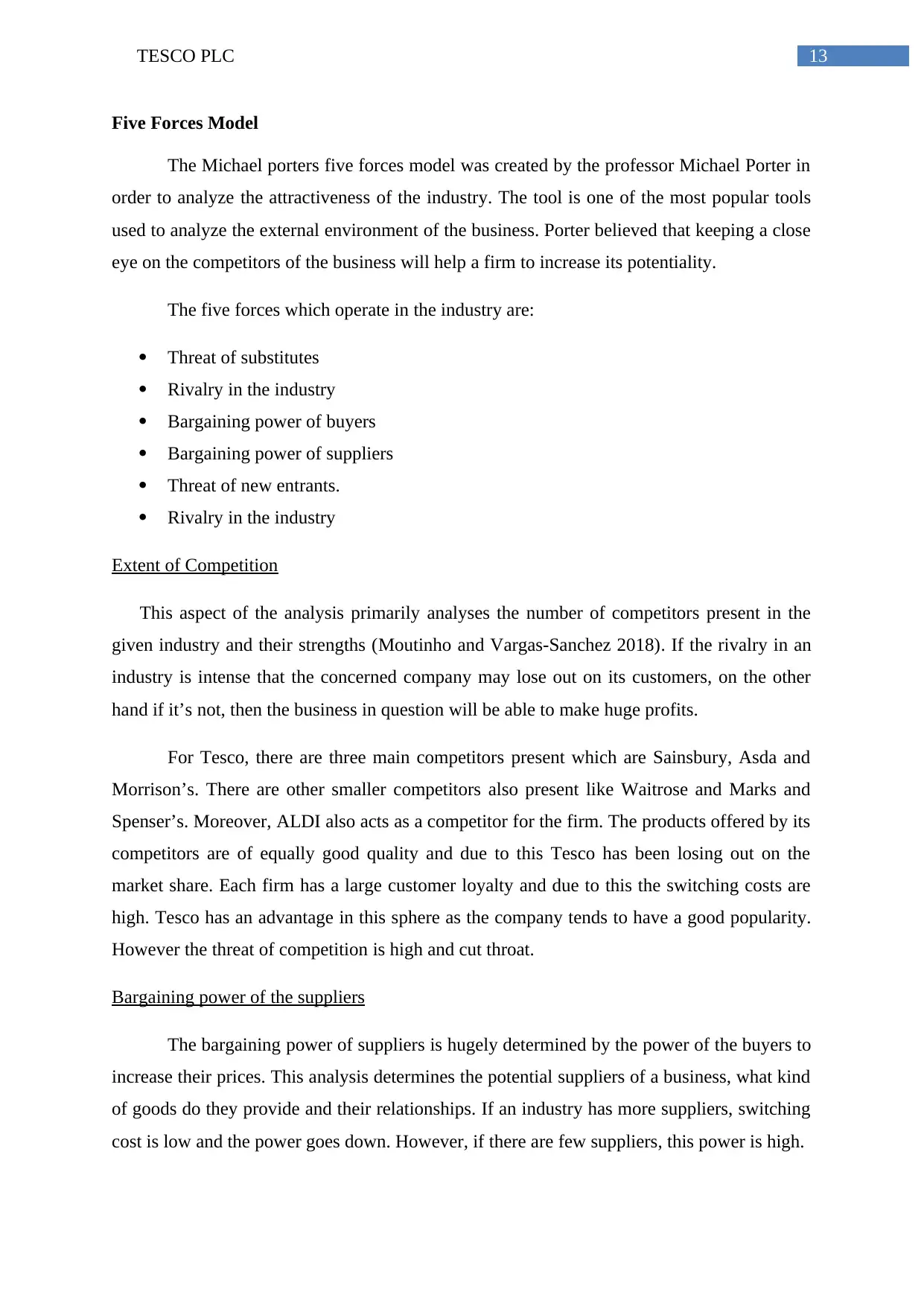
13TESCO PLC
Five Forces Model
The Michael porters five forces model was created by the professor Michael Porter in
order to analyze the attractiveness of the industry. The tool is one of the most popular tools
used to analyze the external environment of the business. Porter believed that keeping a close
eye on the competitors of the business will help a firm to increase its potentiality.
The five forces which operate in the industry are:
Threat of substitutes
Rivalry in the industry
Bargaining power of buyers
Bargaining power of suppliers
Threat of new entrants.
Rivalry in the industry
Extent of Competition
This aspect of the analysis primarily analyses the number of competitors present in the
given industry and their strengths (Moutinho and Vargas-Sanchez 2018). If the rivalry in an
industry is intense that the concerned company may lose out on its customers, on the other
hand if it’s not, then the business in question will be able to make huge profits.
For Tesco, there are three main competitors present which are Sainsbury, Asda and
Morrison’s. There are other smaller competitors also present like Waitrose and Marks and
Spenser’s. Moreover, ALDI also acts as a competitor for the firm. The products offered by its
competitors are of equally good quality and due to this Tesco has been losing out on the
market share. Each firm has a large customer loyalty and due to this the switching costs are
high. Tesco has an advantage in this sphere as the company tends to have a good popularity.
However the threat of competition is high and cut throat.
Bargaining power of the suppliers
The bargaining power of suppliers is hugely determined by the power of the buyers to
increase their prices. This analysis determines the potential suppliers of a business, what kind
of goods do they provide and their relationships. If an industry has more suppliers, switching
cost is low and the power goes down. However, if there are few suppliers, this power is high.
Five Forces Model
The Michael porters five forces model was created by the professor Michael Porter in
order to analyze the attractiveness of the industry. The tool is one of the most popular tools
used to analyze the external environment of the business. Porter believed that keeping a close
eye on the competitors of the business will help a firm to increase its potentiality.
The five forces which operate in the industry are:
Threat of substitutes
Rivalry in the industry
Bargaining power of buyers
Bargaining power of suppliers
Threat of new entrants.
Rivalry in the industry
Extent of Competition
This aspect of the analysis primarily analyses the number of competitors present in the
given industry and their strengths (Moutinho and Vargas-Sanchez 2018). If the rivalry in an
industry is intense that the concerned company may lose out on its customers, on the other
hand if it’s not, then the business in question will be able to make huge profits.
For Tesco, there are three main competitors present which are Sainsbury, Asda and
Morrison’s. There are other smaller competitors also present like Waitrose and Marks and
Spenser’s. Moreover, ALDI also acts as a competitor for the firm. The products offered by its
competitors are of equally good quality and due to this Tesco has been losing out on the
market share. Each firm has a large customer loyalty and due to this the switching costs are
high. Tesco has an advantage in this sphere as the company tends to have a good popularity.
However the threat of competition is high and cut throat.
Bargaining power of the suppliers
The bargaining power of suppliers is hugely determined by the power of the buyers to
increase their prices. This analysis determines the potential suppliers of a business, what kind
of goods do they provide and their relationships. If an industry has more suppliers, switching
cost is low and the power goes down. However, if there are few suppliers, this power is high.
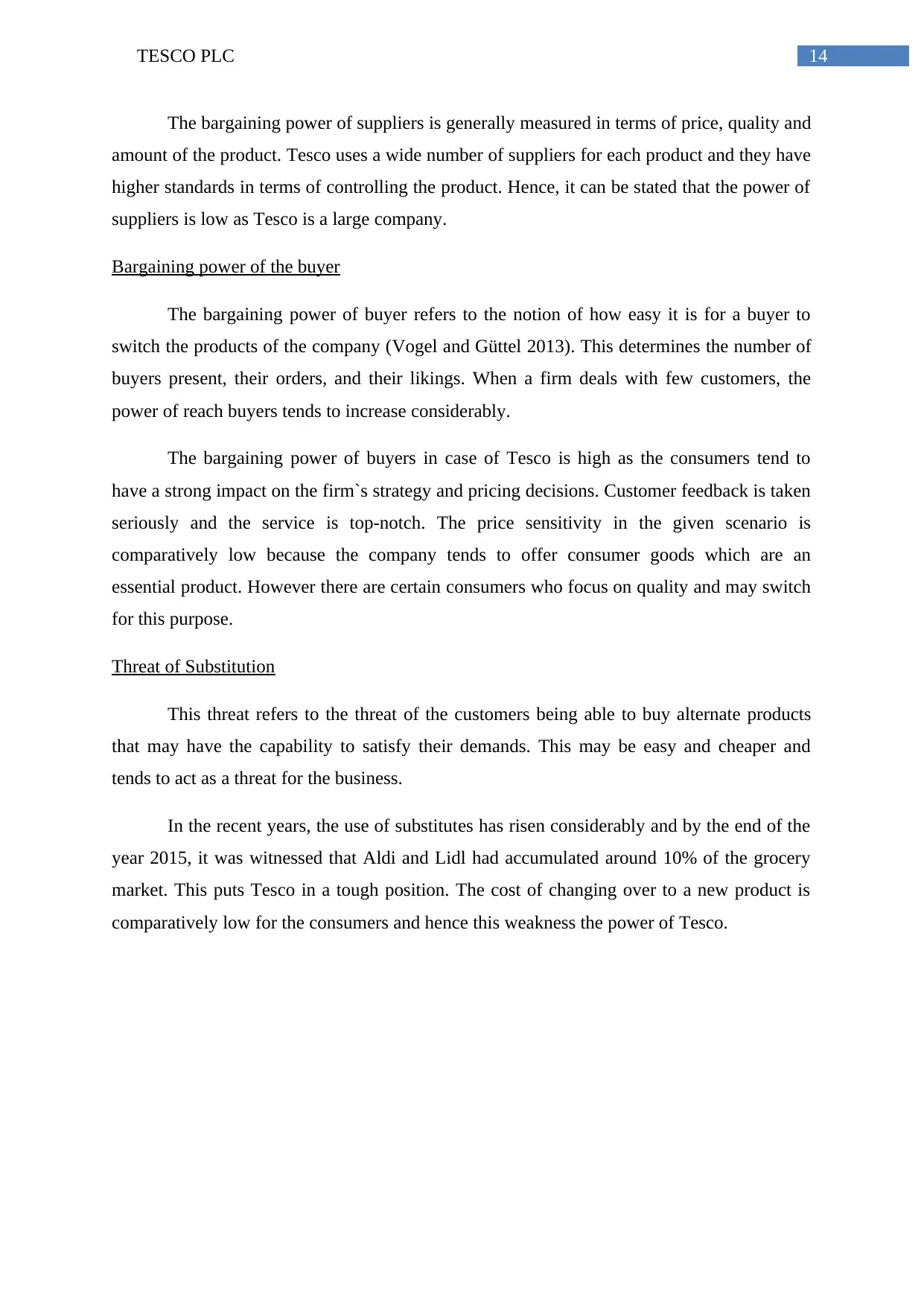
14TESCO PLC
The bargaining power of suppliers is generally measured in terms of price, quality and
amount of the product. Tesco uses a wide number of suppliers for each product and they have
higher standards in terms of controlling the product. Hence, it can be stated that the power of
suppliers is low as Tesco is a large company.
Bargaining power of the buyer
The bargaining power of buyer refers to the notion of how easy it is for a buyer to
switch the products of the company (Vogel and Güttel 2013). This determines the number of
buyers present, their orders, and their likings. When a firm deals with few customers, the
power of reach buyers tends to increase considerably.
The bargaining power of buyers in case of Tesco is high as the consumers tend to
have a strong impact on the firm`s strategy and pricing decisions. Customer feedback is taken
seriously and the service is top-notch. The price sensitivity in the given scenario is
comparatively low because the company tends to offer consumer goods which are an
essential product. However there are certain consumers who focus on quality and may switch
for this purpose.
Threat of Substitution
This threat refers to the threat of the customers being able to buy alternate products
that may have the capability to satisfy their demands. This may be easy and cheaper and
tends to act as a threat for the business.
In the recent years, the use of substitutes has risen considerably and by the end of the
year 2015, it was witnessed that Aldi and Lidl had accumulated around 10% of the grocery
market. This puts Tesco in a tough position. The cost of changing over to a new product is
comparatively low for the consumers and hence this weakness the power of Tesco.
The bargaining power of suppliers is generally measured in terms of price, quality and
amount of the product. Tesco uses a wide number of suppliers for each product and they have
higher standards in terms of controlling the product. Hence, it can be stated that the power of
suppliers is low as Tesco is a large company.
Bargaining power of the buyer
The bargaining power of buyer refers to the notion of how easy it is for a buyer to
switch the products of the company (Vogel and Güttel 2013). This determines the number of
buyers present, their orders, and their likings. When a firm deals with few customers, the
power of reach buyers tends to increase considerably.
The bargaining power of buyers in case of Tesco is high as the consumers tend to
have a strong impact on the firm`s strategy and pricing decisions. Customer feedback is taken
seriously and the service is top-notch. The price sensitivity in the given scenario is
comparatively low because the company tends to offer consumer goods which are an
essential product. However there are certain consumers who focus on quality and may switch
for this purpose.
Threat of Substitution
This threat refers to the threat of the customers being able to buy alternate products
that may have the capability to satisfy their demands. This may be easy and cheaper and
tends to act as a threat for the business.
In the recent years, the use of substitutes has risen considerably and by the end of the
year 2015, it was witnessed that Aldi and Lidl had accumulated around 10% of the grocery
market. This puts Tesco in a tough position. The cost of changing over to a new product is
comparatively low for the consumers and hence this weakness the power of Tesco.
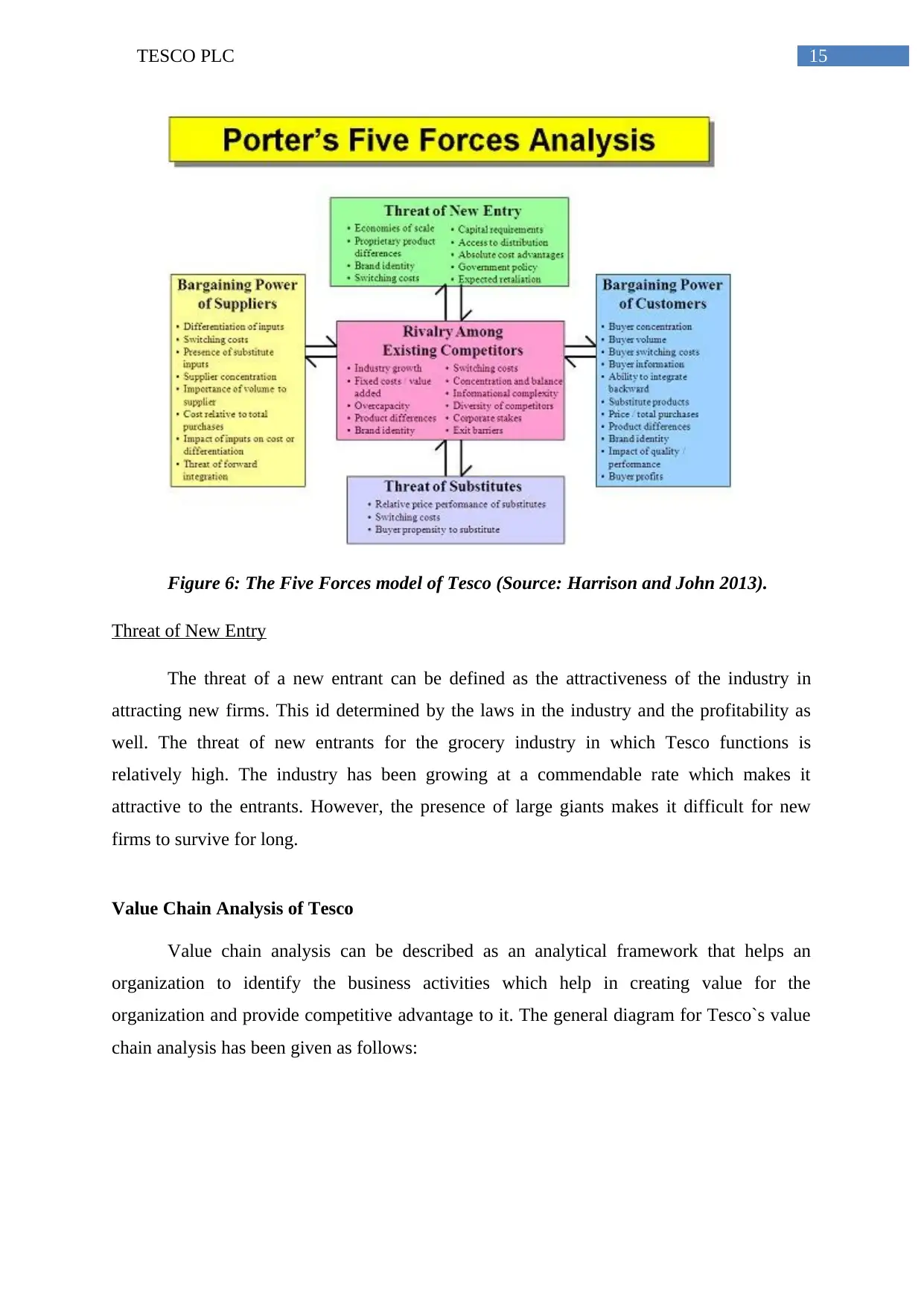
15TESCO PLC
Figure 6: The Five Forces model of Tesco (Source: Harrison and John 2013).
Threat of New Entry
The threat of a new entrant can be defined as the attractiveness of the industry in
attracting new firms. This id determined by the laws in the industry and the profitability as
well. The threat of new entrants for the grocery industry in which Tesco functions is
relatively high. The industry has been growing at a commendable rate which makes it
attractive to the entrants. However, the presence of large giants makes it difficult for new
firms to survive for long.
Value Chain Analysis of Tesco
Value chain analysis can be described as an analytical framework that helps an
organization to identify the business activities which help in creating value for the
organization and provide competitive advantage to it. The general diagram for Tesco`s value
chain analysis has been given as follows:
Figure 6: The Five Forces model of Tesco (Source: Harrison and John 2013).
Threat of New Entry
The threat of a new entrant can be defined as the attractiveness of the industry in
attracting new firms. This id determined by the laws in the industry and the profitability as
well. The threat of new entrants for the grocery industry in which Tesco functions is
relatively high. The industry has been growing at a commendable rate which makes it
attractive to the entrants. However, the presence of large giants makes it difficult for new
firms to survive for long.
Value Chain Analysis of Tesco
Value chain analysis can be described as an analytical framework that helps an
organization to identify the business activities which help in creating value for the
organization and provide competitive advantage to it. The general diagram for Tesco`s value
chain analysis has been given as follows:
Secure Best Marks with AI Grader
Need help grading? Try our AI Grader for instant feedback on your assignments.
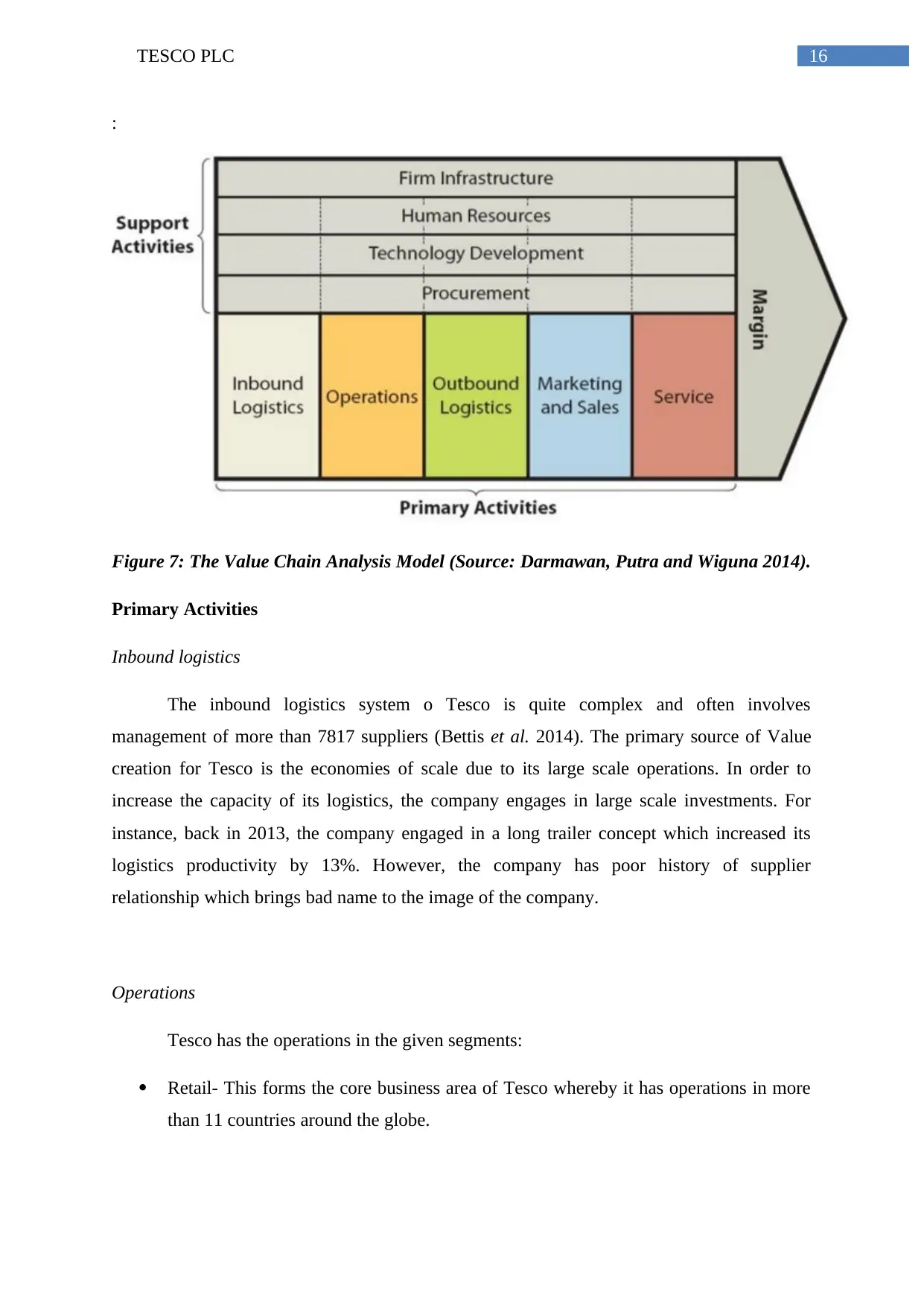
16TESCO PLC
:
Figure 7: The Value Chain Analysis Model (Source: Darmawan, Putra and Wiguna 2014).
Primary Activities
Inbound logistics
The inbound logistics system o Tesco is quite complex and often involves
management of more than 7817 suppliers (Bettis et al. 2014). The primary source of Value
creation for Tesco is the economies of scale due to its large scale operations. In order to
increase the capacity of its logistics, the company engages in large scale investments. For
instance, back in 2013, the company engaged in a long trailer concept which increased its
logistics productivity by 13%. However, the company has poor history of supplier
relationship which brings bad name to the image of the company.
Operations
Tesco has the operations in the given segments:
Retail- This forms the core business area of Tesco whereby it has operations in more
than 11 countries around the globe.
:
Figure 7: The Value Chain Analysis Model (Source: Darmawan, Putra and Wiguna 2014).
Primary Activities
Inbound logistics
The inbound logistics system o Tesco is quite complex and often involves
management of more than 7817 suppliers (Bettis et al. 2014). The primary source of Value
creation for Tesco is the economies of scale due to its large scale operations. In order to
increase the capacity of its logistics, the company engages in large scale investments. For
instance, back in 2013, the company engaged in a long trailer concept which increased its
logistics productivity by 13%. However, the company has poor history of supplier
relationship which brings bad name to the image of the company.
Operations
Tesco has the operations in the given segments:
Retail- This forms the core business area of Tesco whereby it has operations in more
than 11 countries around the globe.
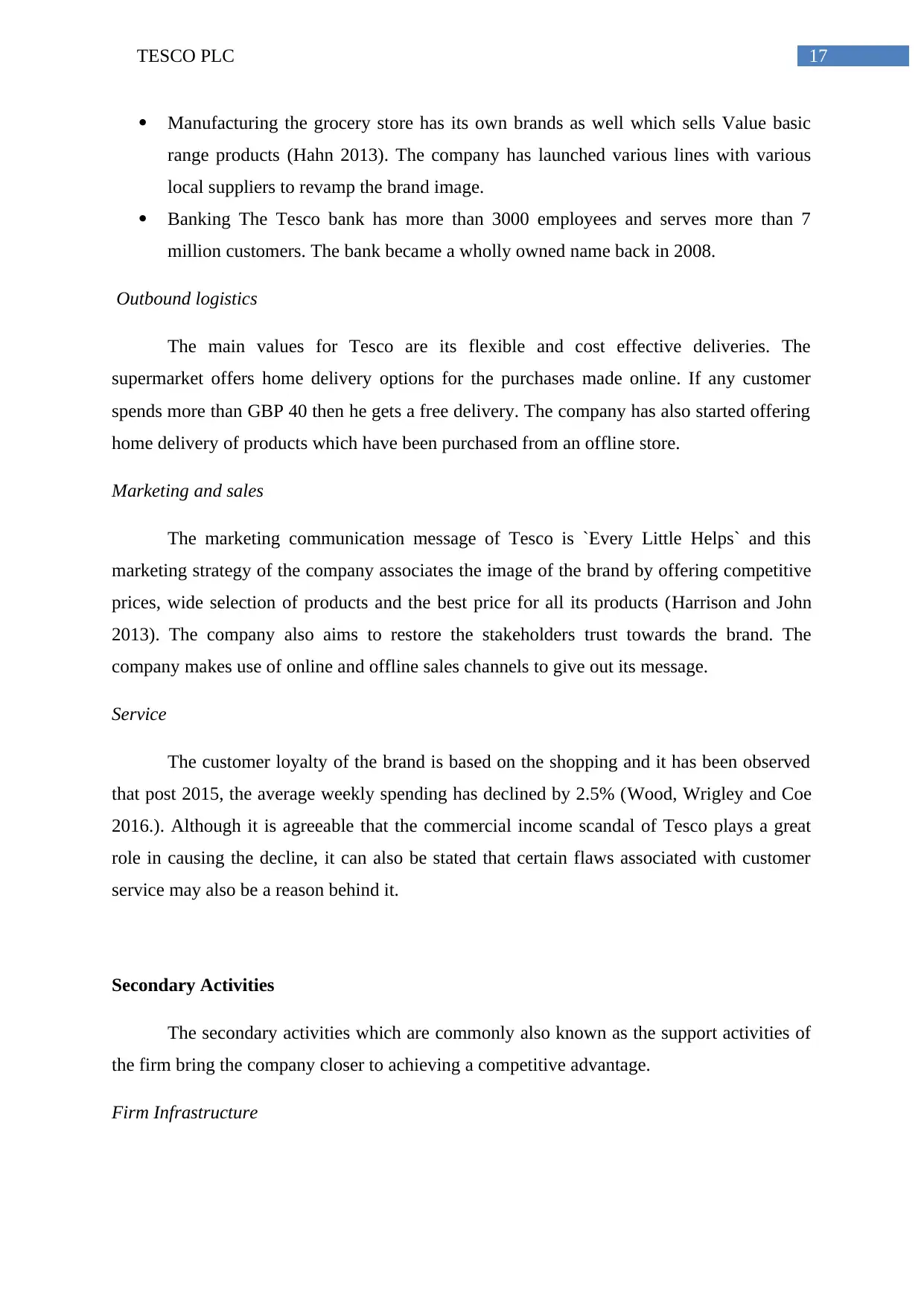
17TESCO PLC
Manufacturing the grocery store has its own brands as well which sells Value basic
range products (Hahn 2013). The company has launched various lines with various
local suppliers to revamp the brand image.
Banking The Tesco bank has more than 3000 employees and serves more than 7
million customers. The bank became a wholly owned name back in 2008.
Outbound logistics
The main values for Tesco are its flexible and cost effective deliveries. The
supermarket offers home delivery options for the purchases made online. If any customer
spends more than GBP 40 then he gets a free delivery. The company has also started offering
home delivery of products which have been purchased from an offline store.
Marketing and sales
The marketing communication message of Tesco is `Every Little Helps` and this
marketing strategy of the company associates the image of the brand by offering competitive
prices, wide selection of products and the best price for all its products (Harrison and John
2013). The company also aims to restore the stakeholders trust towards the brand. The
company makes use of online and offline sales channels to give out its message.
Service
The customer loyalty of the brand is based on the shopping and it has been observed
that post 2015, the average weekly spending has declined by 2.5% (Wood, Wrigley and Coe
2016.). Although it is agreeable that the commercial income scandal of Tesco plays a great
role in causing the decline, it can also be stated that certain flaws associated with customer
service may also be a reason behind it.
Secondary Activities
The secondary activities which are commonly also known as the support activities of
the firm bring the company closer to achieving a competitive advantage.
Firm Infrastructure
Manufacturing the grocery store has its own brands as well which sells Value basic
range products (Hahn 2013). The company has launched various lines with various
local suppliers to revamp the brand image.
Banking The Tesco bank has more than 3000 employees and serves more than 7
million customers. The bank became a wholly owned name back in 2008.
Outbound logistics
The main values for Tesco are its flexible and cost effective deliveries. The
supermarket offers home delivery options for the purchases made online. If any customer
spends more than GBP 40 then he gets a free delivery. The company has also started offering
home delivery of products which have been purchased from an offline store.
Marketing and sales
The marketing communication message of Tesco is `Every Little Helps` and this
marketing strategy of the company associates the image of the brand by offering competitive
prices, wide selection of products and the best price for all its products (Harrison and John
2013). The company also aims to restore the stakeholders trust towards the brand. The
company makes use of online and offline sales channels to give out its message.
Service
The customer loyalty of the brand is based on the shopping and it has been observed
that post 2015, the average weekly spending has declined by 2.5% (Wood, Wrigley and Coe
2016.). Although it is agreeable that the commercial income scandal of Tesco plays a great
role in causing the decline, it can also be stated that certain flaws associated with customer
service may also be a reason behind it.
Secondary Activities
The secondary activities which are commonly also known as the support activities of
the firm bring the company closer to achieving a competitive advantage.
Firm Infrastructure
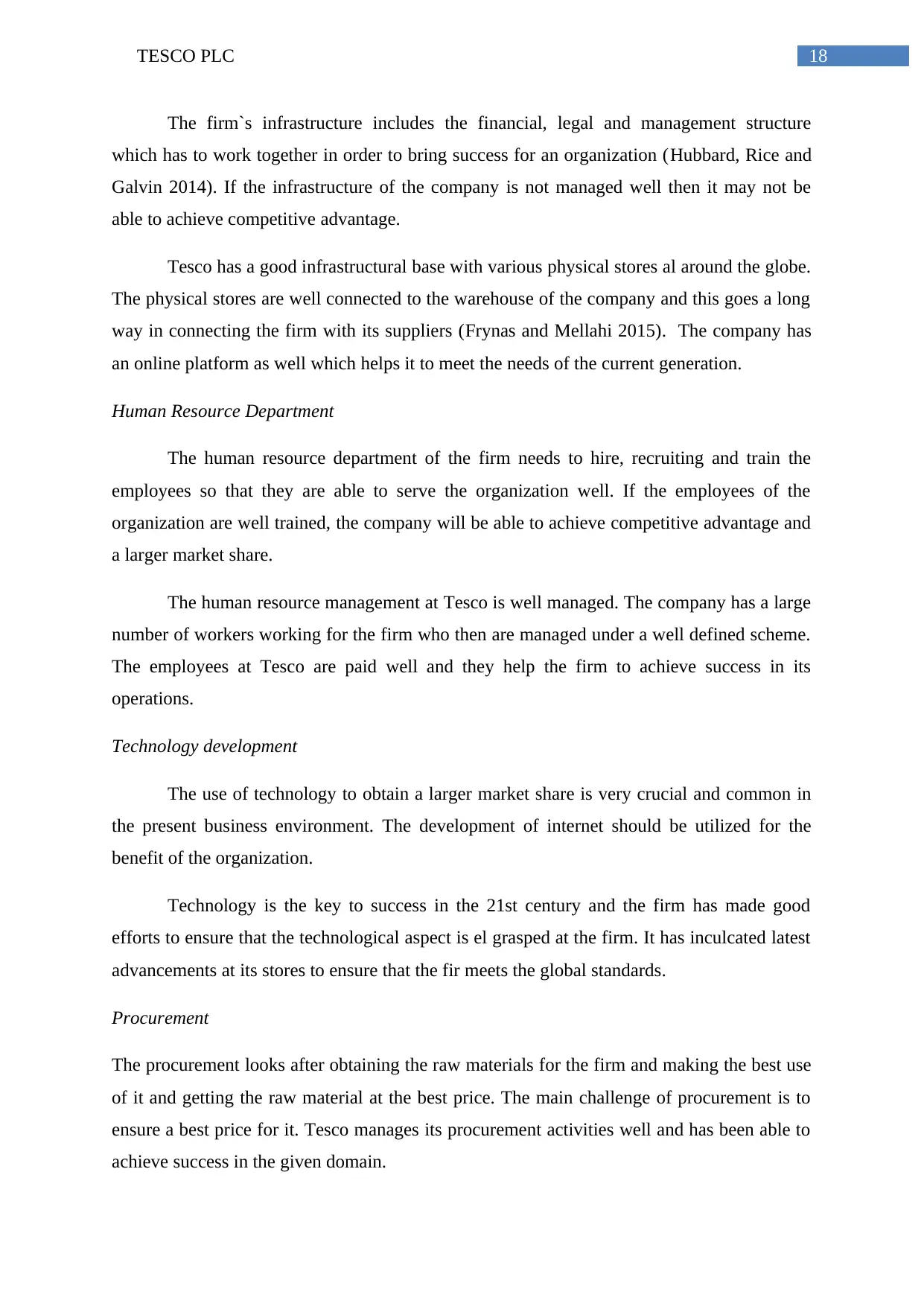
18TESCO PLC
The firm`s infrastructure includes the financial, legal and management structure
which has to work together in order to bring success for an organization (Hubbard, Rice and
Galvin 2014). If the infrastructure of the company is not managed well then it may not be
able to achieve competitive advantage.
Tesco has a good infrastructural base with various physical stores al around the globe.
The physical stores are well connected to the warehouse of the company and this goes a long
way in connecting the firm with its suppliers (Frynas and Mellahi 2015). The company has
an online platform as well which helps it to meet the needs of the current generation.
Human Resource Department
The human resource department of the firm needs to hire, recruiting and train the
employees so that they are able to serve the organization well. If the employees of the
organization are well trained, the company will be able to achieve competitive advantage and
a larger market share.
The human resource management at Tesco is well managed. The company has a large
number of workers working for the firm who then are managed under a well defined scheme.
The employees at Tesco are paid well and they help the firm to achieve success in its
operations.
Technology development
The use of technology to obtain a larger market share is very crucial and common in
the present business environment. The development of internet should be utilized for the
benefit of the organization.
Technology is the key to success in the 21st century and the firm has made good
efforts to ensure that the technological aspect is el grasped at the firm. It has inculcated latest
advancements at its stores to ensure that the fir meets the global standards.
Procurement
The procurement looks after obtaining the raw materials for the firm and making the best use
of it and getting the raw material at the best price. The main challenge of procurement is to
ensure a best price for it. Tesco manages its procurement activities well and has been able to
achieve success in the given domain.
The firm`s infrastructure includes the financial, legal and management structure
which has to work together in order to bring success for an organization (Hubbard, Rice and
Galvin 2014). If the infrastructure of the company is not managed well then it may not be
able to achieve competitive advantage.
Tesco has a good infrastructural base with various physical stores al around the globe.
The physical stores are well connected to the warehouse of the company and this goes a long
way in connecting the firm with its suppliers (Frynas and Mellahi 2015). The company has
an online platform as well which helps it to meet the needs of the current generation.
Human Resource Department
The human resource department of the firm needs to hire, recruiting and train the
employees so that they are able to serve the organization well. If the employees of the
organization are well trained, the company will be able to achieve competitive advantage and
a larger market share.
The human resource management at Tesco is well managed. The company has a large
number of workers working for the firm who then are managed under a well defined scheme.
The employees at Tesco are paid well and they help the firm to achieve success in its
operations.
Technology development
The use of technology to obtain a larger market share is very crucial and common in
the present business environment. The development of internet should be utilized for the
benefit of the organization.
Technology is the key to success in the 21st century and the firm has made good
efforts to ensure that the technological aspect is el grasped at the firm. It has inculcated latest
advancements at its stores to ensure that the fir meets the global standards.
Procurement
The procurement looks after obtaining the raw materials for the firm and making the best use
of it and getting the raw material at the best price. The main challenge of procurement is to
ensure a best price for it. Tesco manages its procurement activities well and has been able to
achieve success in the given domain.
Paraphrase This Document
Need a fresh take? Get an instant paraphrase of this document with our AI Paraphraser
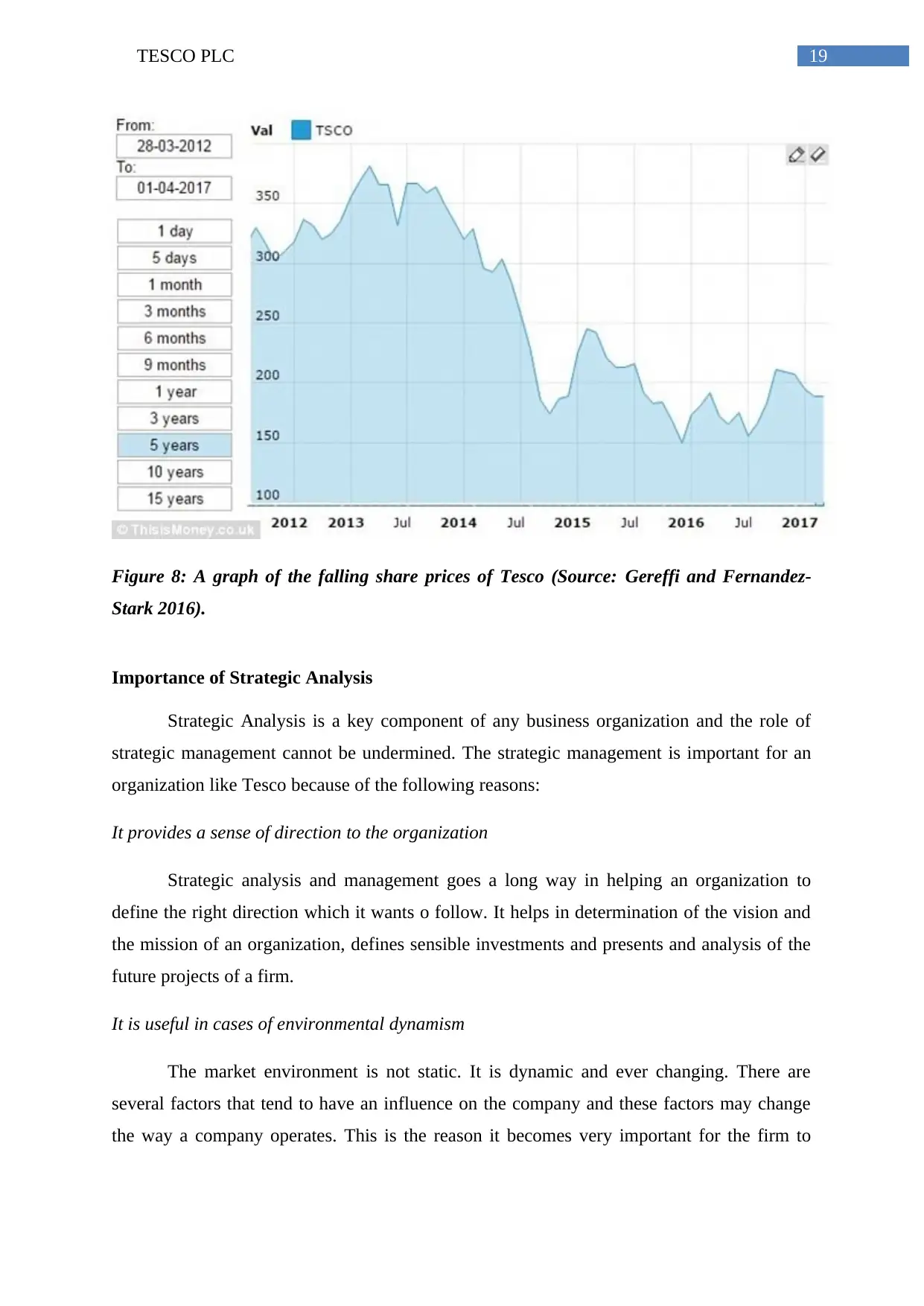
19TESCO PLC
Figure 8: A graph of the falling share prices of Tesco (Source: Gereffi and Fernandez-
Stark 2016).
Importance of Strategic Analysis
Strategic Analysis is a key component of any business organization and the role of
strategic management cannot be undermined. The strategic management is important for an
organization like Tesco because of the following reasons:
It provides a sense of direction to the organization
Strategic analysis and management goes a long way in helping an organization to
define the right direction which it wants o follow. It helps in determination of the vision and
the mission of an organization, defines sensible investments and presents and analysis of the
future projects of a firm.
It is useful in cases of environmental dynamism
The market environment is not static. It is dynamic and ever changing. There are
several factors that tend to have an influence on the company and these factors may change
the way a company operates. This is the reason it becomes very important for the firm to
Figure 8: A graph of the falling share prices of Tesco (Source: Gereffi and Fernandez-
Stark 2016).
Importance of Strategic Analysis
Strategic Analysis is a key component of any business organization and the role of
strategic management cannot be undermined. The strategic management is important for an
organization like Tesco because of the following reasons:
It provides a sense of direction to the organization
Strategic analysis and management goes a long way in helping an organization to
define the right direction which it wants o follow. It helps in determination of the vision and
the mission of an organization, defines sensible investments and presents and analysis of the
future projects of a firm.
It is useful in cases of environmental dynamism
The market environment is not static. It is dynamic and ever changing. There are
several factors that tend to have an influence on the company and these factors may change
the way a company operates. This is the reason it becomes very important for the firm to
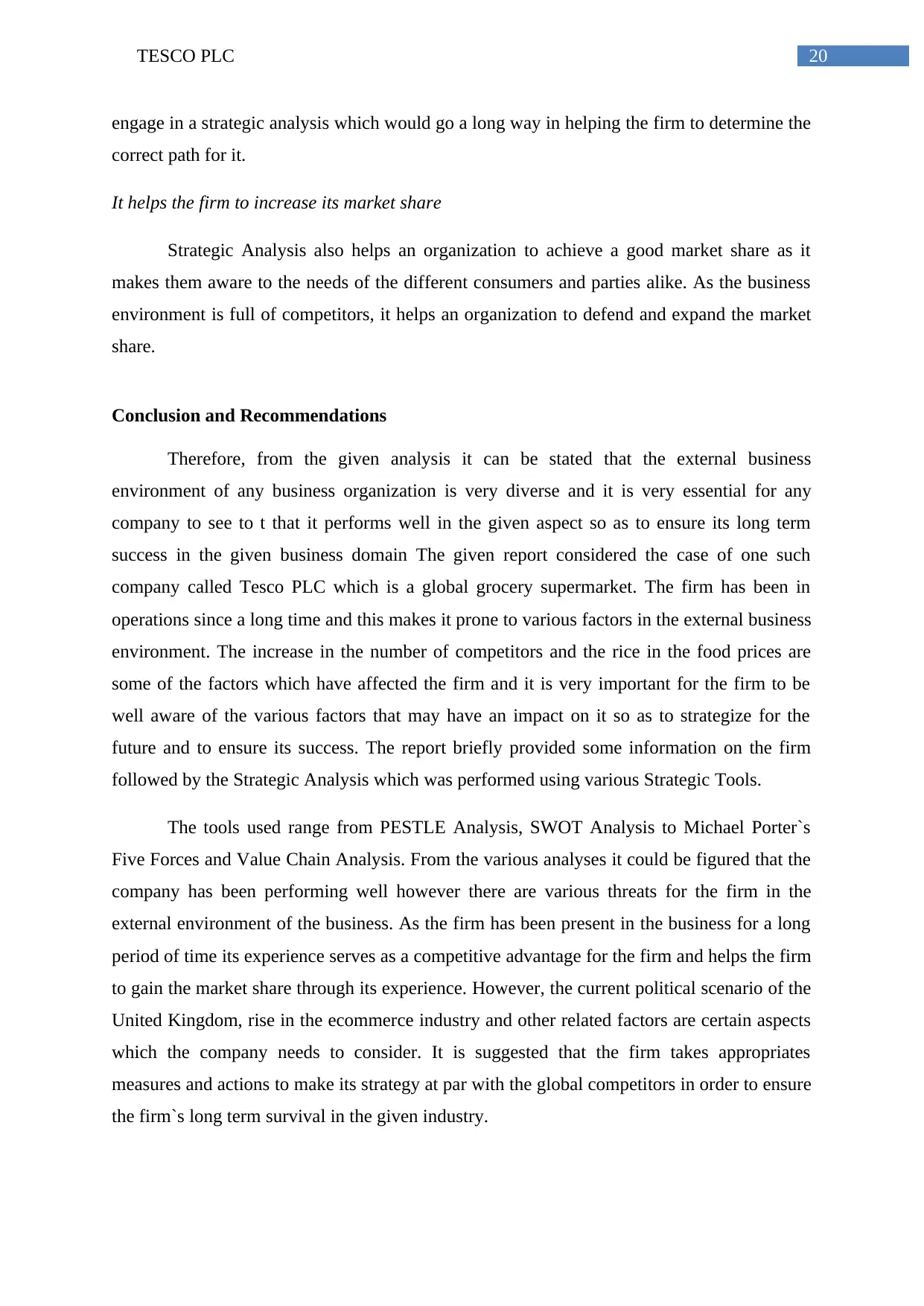
20TESCO PLC
engage in a strategic analysis which would go a long way in helping the firm to determine the
correct path for it.
It helps the firm to increase its market share
Strategic Analysis also helps an organization to achieve a good market share as it
makes them aware to the needs of the different consumers and parties alike. As the business
environment is full of competitors, it helps an organization to defend and expand the market
share.
Conclusion and Recommendations
Therefore, from the given analysis it can be stated that the external business
environment of any business organization is very diverse and it is very essential for any
company to see to t that it performs well in the given aspect so as to ensure its long term
success in the given business domain The given report considered the case of one such
company called Tesco PLC which is a global grocery supermarket. The firm has been in
operations since a long time and this makes it prone to various factors in the external business
environment. The increase in the number of competitors and the rice in the food prices are
some of the factors which have affected the firm and it is very important for the firm to be
well aware of the various factors that may have an impact on it so as to strategize for the
future and to ensure its success. The report briefly provided some information on the firm
followed by the Strategic Analysis which was performed using various Strategic Tools.
The tools used range from PESTLE Analysis, SWOT Analysis to Michael Porter`s
Five Forces and Value Chain Analysis. From the various analyses it could be figured that the
company has been performing well however there are various threats for the firm in the
external environment of the business. As the firm has been present in the business for a long
period of time its experience serves as a competitive advantage for the firm and helps the firm
to gain the market share through its experience. However, the current political scenario of the
United Kingdom, rise in the ecommerce industry and other related factors are certain aspects
which the company needs to consider. It is suggested that the firm takes appropriates
measures and actions to make its strategy at par with the global competitors in order to ensure
the firm`s long term survival in the given industry.
engage in a strategic analysis which would go a long way in helping the firm to determine the
correct path for it.
It helps the firm to increase its market share
Strategic Analysis also helps an organization to achieve a good market share as it
makes them aware to the needs of the different consumers and parties alike. As the business
environment is full of competitors, it helps an organization to defend and expand the market
share.
Conclusion and Recommendations
Therefore, from the given analysis it can be stated that the external business
environment of any business organization is very diverse and it is very essential for any
company to see to t that it performs well in the given aspect so as to ensure its long term
success in the given business domain The given report considered the case of one such
company called Tesco PLC which is a global grocery supermarket. The firm has been in
operations since a long time and this makes it prone to various factors in the external business
environment. The increase in the number of competitors and the rice in the food prices are
some of the factors which have affected the firm and it is very important for the firm to be
well aware of the various factors that may have an impact on it so as to strategize for the
future and to ensure its success. The report briefly provided some information on the firm
followed by the Strategic Analysis which was performed using various Strategic Tools.
The tools used range from PESTLE Analysis, SWOT Analysis to Michael Porter`s
Five Forces and Value Chain Analysis. From the various analyses it could be figured that the
company has been performing well however there are various threats for the firm in the
external environment of the business. As the firm has been present in the business for a long
period of time its experience serves as a competitive advantage for the firm and helps the firm
to gain the market share through its experience. However, the current political scenario of the
United Kingdom, rise in the ecommerce industry and other related factors are certain aspects
which the company needs to consider. It is suggested that the firm takes appropriates
measures and actions to make its strategy at par with the global competitors in order to ensure
the firm`s long term survival in the given industry.
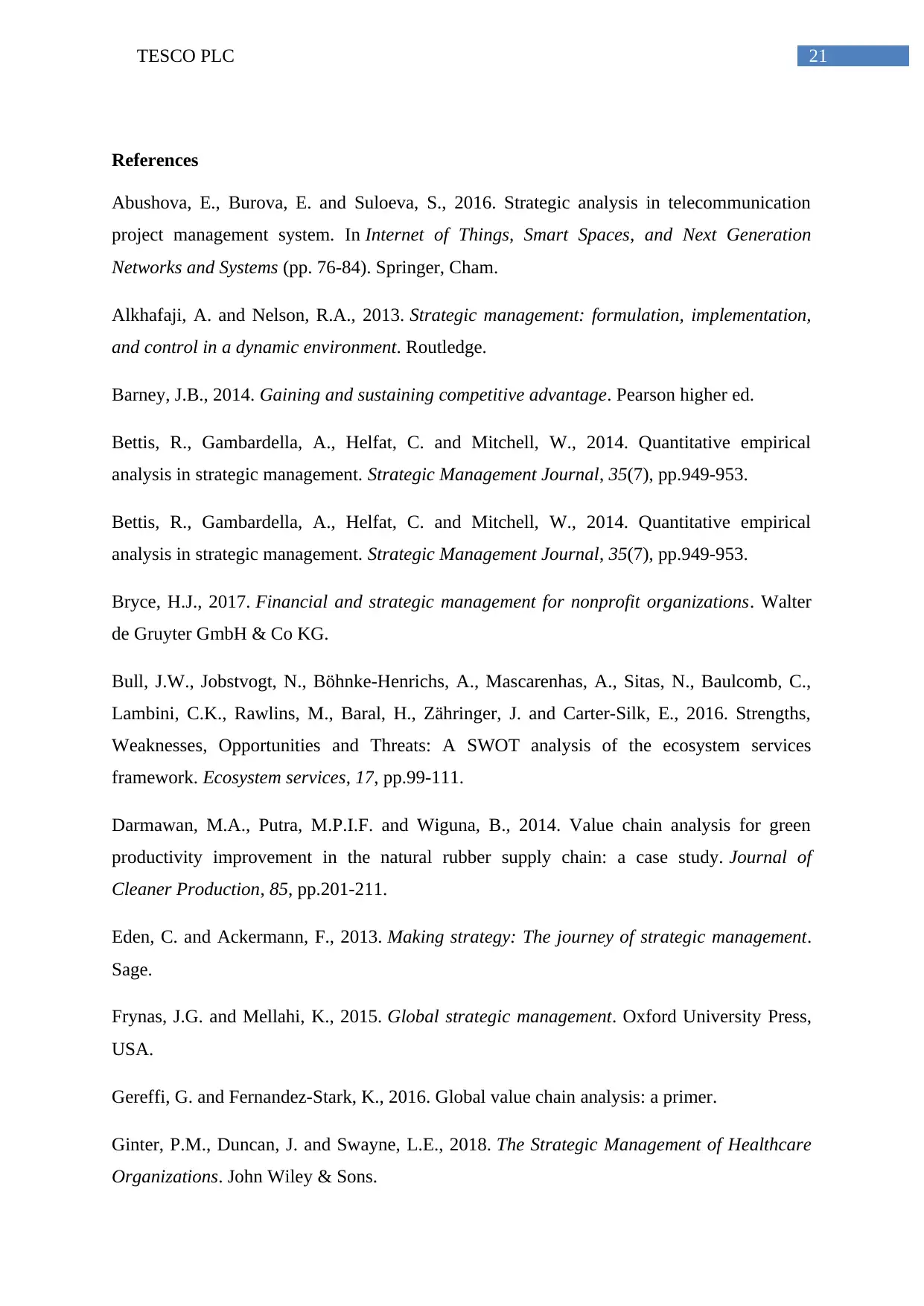
21TESCO PLC
References
Abushova, E., Burova, E. and Suloeva, S., 2016. Strategic analysis in telecommunication
project management system. In Internet of Things, Smart Spaces, and Next Generation
Networks and Systems (pp. 76-84). Springer, Cham.
Alkhafaji, A. and Nelson, R.A., 2013. Strategic management: formulation, implementation,
and control in a dynamic environment. Routledge.
Barney, J.B., 2014. Gaining and sustaining competitive advantage. Pearson higher ed.
Bettis, R., Gambardella, A., Helfat, C. and Mitchell, W., 2014. Quantitative empirical
analysis in strategic management. Strategic Management Journal, 35(7), pp.949-953.
Bettis, R., Gambardella, A., Helfat, C. and Mitchell, W., 2014. Quantitative empirical
analysis in strategic management. Strategic Management Journal, 35(7), pp.949-953.
Bryce, H.J., 2017. Financial and strategic management for nonprofit organizations. Walter
de Gruyter GmbH & Co KG.
Bull, J.W., Jobstvogt, N., Böhnke-Henrichs, A., Mascarenhas, A., Sitas, N., Baulcomb, C.,
Lambini, C.K., Rawlins, M., Baral, H., Zähringer, J. and Carter-Silk, E., 2016. Strengths,
Weaknesses, Opportunities and Threats: A SWOT analysis of the ecosystem services
framework. Ecosystem services, 17, pp.99-111.
Darmawan, M.A., Putra, M.P.I.F. and Wiguna, B., 2014. Value chain analysis for green
productivity improvement in the natural rubber supply chain: a case study. Journal of
Cleaner Production, 85, pp.201-211.
Eden, C. and Ackermann, F., 2013. Making strategy: The journey of strategic management.
Sage.
Frynas, J.G. and Mellahi, K., 2015. Global strategic management. Oxford University Press,
USA.
Gereffi, G. and Fernandez-Stark, K., 2016. Global value chain analysis: a primer.
Ginter, P.M., Duncan, J. and Swayne, L.E., 2018. The Strategic Management of Healthcare
Organizations. John Wiley & Sons.
References
Abushova, E., Burova, E. and Suloeva, S., 2016. Strategic analysis in telecommunication
project management system. In Internet of Things, Smart Spaces, and Next Generation
Networks and Systems (pp. 76-84). Springer, Cham.
Alkhafaji, A. and Nelson, R.A., 2013. Strategic management: formulation, implementation,
and control in a dynamic environment. Routledge.
Barney, J.B., 2014. Gaining and sustaining competitive advantage. Pearson higher ed.
Bettis, R., Gambardella, A., Helfat, C. and Mitchell, W., 2014. Quantitative empirical
analysis in strategic management. Strategic Management Journal, 35(7), pp.949-953.
Bettis, R., Gambardella, A., Helfat, C. and Mitchell, W., 2014. Quantitative empirical
analysis in strategic management. Strategic Management Journal, 35(7), pp.949-953.
Bryce, H.J., 2017. Financial and strategic management for nonprofit organizations. Walter
de Gruyter GmbH & Co KG.
Bull, J.W., Jobstvogt, N., Böhnke-Henrichs, A., Mascarenhas, A., Sitas, N., Baulcomb, C.,
Lambini, C.K., Rawlins, M., Baral, H., Zähringer, J. and Carter-Silk, E., 2016. Strengths,
Weaknesses, Opportunities and Threats: A SWOT analysis of the ecosystem services
framework. Ecosystem services, 17, pp.99-111.
Darmawan, M.A., Putra, M.P.I.F. and Wiguna, B., 2014. Value chain analysis for green
productivity improvement in the natural rubber supply chain: a case study. Journal of
Cleaner Production, 85, pp.201-211.
Eden, C. and Ackermann, F., 2013. Making strategy: The journey of strategic management.
Sage.
Frynas, J.G. and Mellahi, K., 2015. Global strategic management. Oxford University Press,
USA.
Gereffi, G. and Fernandez-Stark, K., 2016. Global value chain analysis: a primer.
Ginter, P.M., Duncan, J. and Swayne, L.E., 2018. The Strategic Management of Healthcare
Organizations. John Wiley & Sons.
Secure Best Marks with AI Grader
Need help grading? Try our AI Grader for instant feedback on your assignments.
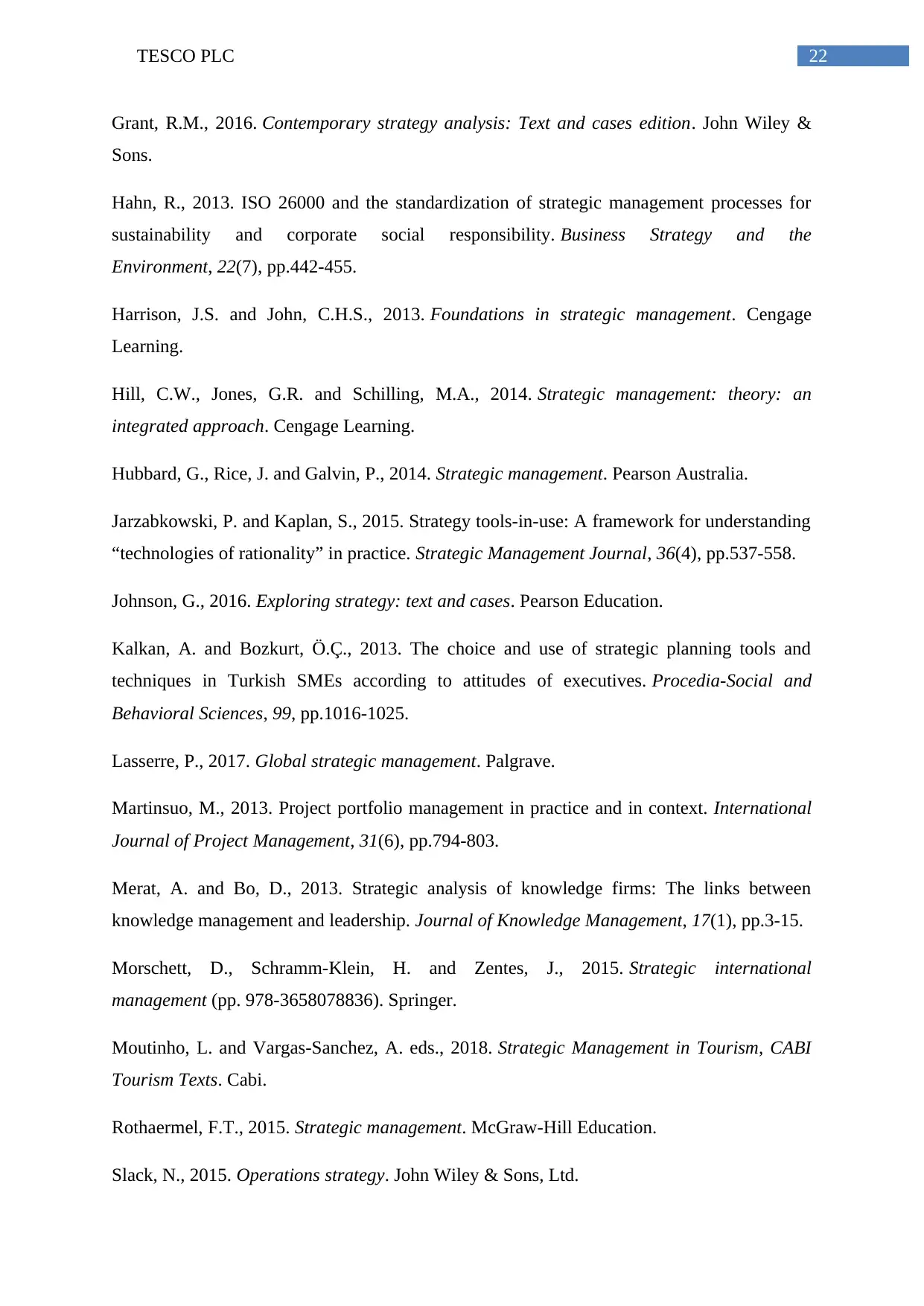
22TESCO PLC
Grant, R.M., 2016. Contemporary strategy analysis: Text and cases edition. John Wiley &
Sons.
Hahn, R., 2013. ISO 26000 and the standardization of strategic management processes for
sustainability and corporate social responsibility. Business Strategy and the
Environment, 22(7), pp.442-455.
Harrison, J.S. and John, C.H.S., 2013. Foundations in strategic management. Cengage
Learning.
Hill, C.W., Jones, G.R. and Schilling, M.A., 2014. Strategic management: theory: an
integrated approach. Cengage Learning.
Hubbard, G., Rice, J. and Galvin, P., 2014. Strategic management. Pearson Australia.
Jarzabkowski, P. and Kaplan, S., 2015. Strategy tools‐in‐use: A framework for understanding
“technologies of rationality” in practice. Strategic Management Journal, 36(4), pp.537-558.
Johnson, G., 2016. Exploring strategy: text and cases. Pearson Education.
Kalkan, A. and Bozkurt, Ö.Ç., 2013. The choice and use of strategic planning tools and
techniques in Turkish SMEs according to attitudes of executives. Procedia-Social and
Behavioral Sciences, 99, pp.1016-1025.
Lasserre, P., 2017. Global strategic management. Palgrave.
Martinsuo, M., 2013. Project portfolio management in practice and in context. International
Journal of Project Management, 31(6), pp.794-803.
Merat, A. and Bo, D., 2013. Strategic analysis of knowledge firms: The links between
knowledge management and leadership. Journal of Knowledge Management, 17(1), pp.3-15.
Morschett, D., Schramm-Klein, H. and Zentes, J., 2015. Strategic international
management (pp. 978-3658078836). Springer.
Moutinho, L. and Vargas-Sanchez, A. eds., 2018. Strategic Management in Tourism, CABI
Tourism Texts. Cabi.
Rothaermel, F.T., 2015. Strategic management. McGraw-Hill Education.
Slack, N., 2015. Operations strategy. John Wiley & Sons, Ltd.
Grant, R.M., 2016. Contemporary strategy analysis: Text and cases edition. John Wiley &
Sons.
Hahn, R., 2013. ISO 26000 and the standardization of strategic management processes for
sustainability and corporate social responsibility. Business Strategy and the
Environment, 22(7), pp.442-455.
Harrison, J.S. and John, C.H.S., 2013. Foundations in strategic management. Cengage
Learning.
Hill, C.W., Jones, G.R. and Schilling, M.A., 2014. Strategic management: theory: an
integrated approach. Cengage Learning.
Hubbard, G., Rice, J. and Galvin, P., 2014. Strategic management. Pearson Australia.
Jarzabkowski, P. and Kaplan, S., 2015. Strategy tools‐in‐use: A framework for understanding
“technologies of rationality” in practice. Strategic Management Journal, 36(4), pp.537-558.
Johnson, G., 2016. Exploring strategy: text and cases. Pearson Education.
Kalkan, A. and Bozkurt, Ö.Ç., 2013. The choice and use of strategic planning tools and
techniques in Turkish SMEs according to attitudes of executives. Procedia-Social and
Behavioral Sciences, 99, pp.1016-1025.
Lasserre, P., 2017. Global strategic management. Palgrave.
Martinsuo, M., 2013. Project portfolio management in practice and in context. International
Journal of Project Management, 31(6), pp.794-803.
Merat, A. and Bo, D., 2013. Strategic analysis of knowledge firms: The links between
knowledge management and leadership. Journal of Knowledge Management, 17(1), pp.3-15.
Morschett, D., Schramm-Klein, H. and Zentes, J., 2015. Strategic international
management (pp. 978-3658078836). Springer.
Moutinho, L. and Vargas-Sanchez, A. eds., 2018. Strategic Management in Tourism, CABI
Tourism Texts. Cabi.
Rothaermel, F.T., 2015. Strategic management. McGraw-Hill Education.
Slack, N., 2015. Operations strategy. John Wiley & Sons, Ltd.
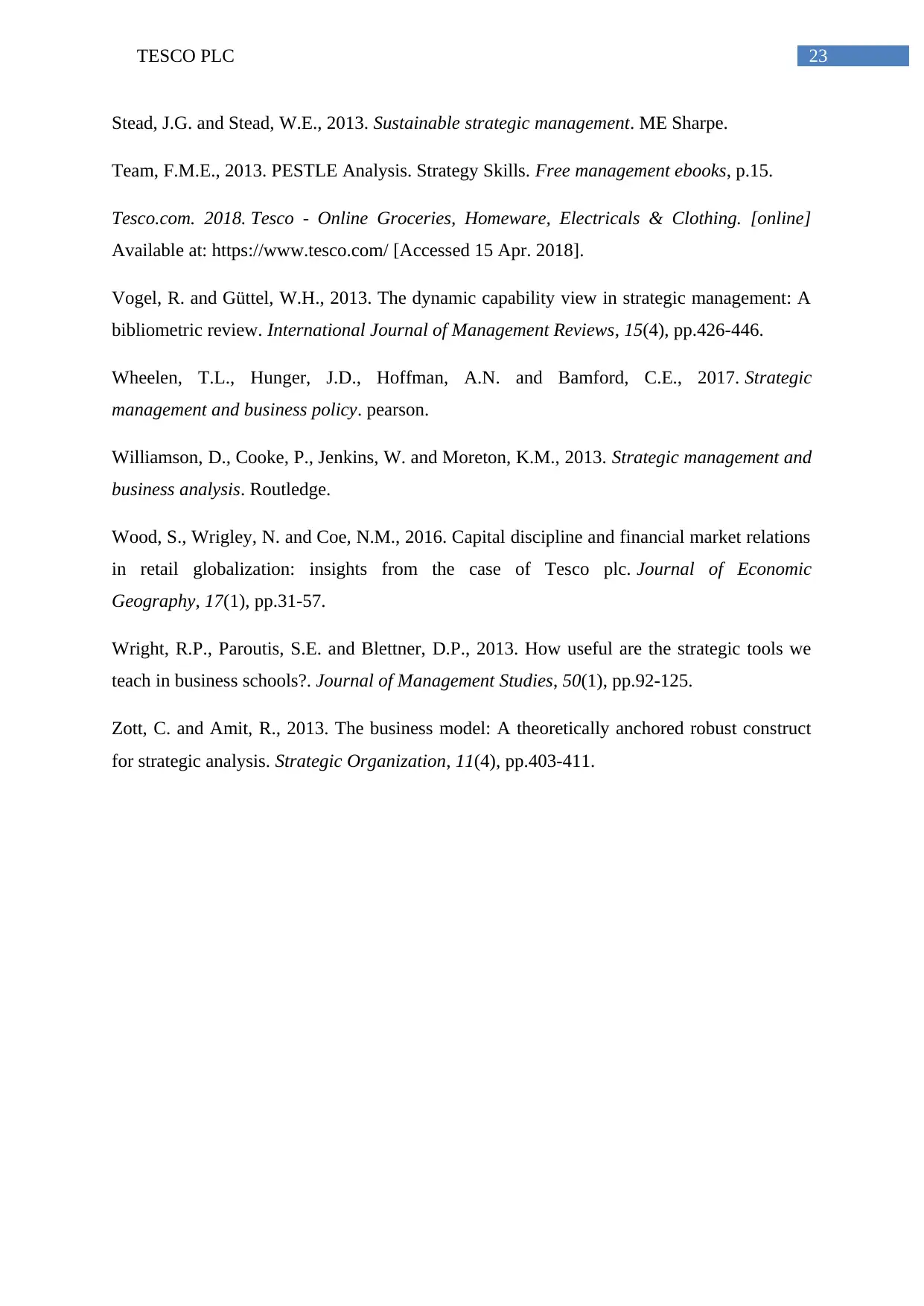
23TESCO PLC
Stead, J.G. and Stead, W.E., 2013. Sustainable strategic management. ME Sharpe.
Team, F.M.E., 2013. PESTLE Analysis. Strategy Skills. Free management ebooks, p.15.
Tesco.com. 2018. Tesco - Online Groceries, Homeware, Electricals & Clothing. [online]
Available at: https://www.tesco.com/ [Accessed 15 Apr. 2018].
Vogel, R. and Güttel, W.H., 2013. The dynamic capability view in strategic management: A
bibliometric review. International Journal of Management Reviews, 15(4), pp.426-446.
Wheelen, T.L., Hunger, J.D., Hoffman, A.N. and Bamford, C.E., 2017. Strategic
management and business policy. pearson.
Williamson, D., Cooke, P., Jenkins, W. and Moreton, K.M., 2013. Strategic management and
business analysis. Routledge.
Wood, S., Wrigley, N. and Coe, N.M., 2016. Capital discipline and financial market relations
in retail globalization: insights from the case of Tesco plc. Journal of Economic
Geography, 17(1), pp.31-57.
Wright, R.P., Paroutis, S.E. and Blettner, D.P., 2013. How useful are the strategic tools we
teach in business schools?. Journal of Management Studies, 50(1), pp.92-125.
Zott, C. and Amit, R., 2013. The business model: A theoretically anchored robust construct
for strategic analysis. Strategic Organization, 11(4), pp.403-411.
Stead, J.G. and Stead, W.E., 2013. Sustainable strategic management. ME Sharpe.
Team, F.M.E., 2013. PESTLE Analysis. Strategy Skills. Free management ebooks, p.15.
Tesco.com. 2018. Tesco - Online Groceries, Homeware, Electricals & Clothing. [online]
Available at: https://www.tesco.com/ [Accessed 15 Apr. 2018].
Vogel, R. and Güttel, W.H., 2013. The dynamic capability view in strategic management: A
bibliometric review. International Journal of Management Reviews, 15(4), pp.426-446.
Wheelen, T.L., Hunger, J.D., Hoffman, A.N. and Bamford, C.E., 2017. Strategic
management and business policy. pearson.
Williamson, D., Cooke, P., Jenkins, W. and Moreton, K.M., 2013. Strategic management and
business analysis. Routledge.
Wood, S., Wrigley, N. and Coe, N.M., 2016. Capital discipline and financial market relations
in retail globalization: insights from the case of Tesco plc. Journal of Economic
Geography, 17(1), pp.31-57.
Wright, R.P., Paroutis, S.E. and Blettner, D.P., 2013. How useful are the strategic tools we
teach in business schools?. Journal of Management Studies, 50(1), pp.92-125.
Zott, C. and Amit, R., 2013. The business model: A theoretically anchored robust construct
for strategic analysis. Strategic Organization, 11(4), pp.403-411.
1 out of 24
Related Documents
Your All-in-One AI-Powered Toolkit for Academic Success.
+13062052269
info@desklib.com
Available 24*7 on WhatsApp / Email
![[object Object]](/_next/static/media/star-bottom.7253800d.svg)
Unlock your academic potential
© 2024 | Zucol Services PVT LTD | All rights reserved.





